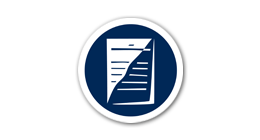Corona Crisis: 02 Middle East and 03 Asia
Newspaper front pages about the Corona Crisis from around the globe are presented here. These are examples from February to May 2020 from Middle East and Asia
Newspaper front pages about the Corona Crisis from around the globe are presented here. These are examples from February to May 2020 from Middle East and Asia
Newspaper front pages about the Corona Crisis from around the globe are presented here. These are examples from February to May 2020 from Oceania.
Newspaper front pages about the Corona Crisis from around the globe are presented here. These are examples from February to May 2020 from Canada.
Newspaper front pages about the Corona Crisis from around the globe are presented here. These are examples from February to May 2020 from the USA.
Newspaper front pages about the Corona Crisis from around the globe are presented here. These are examples from February to May 2020 from both Central and South America.
Websites about the Corona Crisis from around the world are presented here. These are examples from February to May 2020.
Magazine pages about the Corona Crisis from around the world are presented here. These are pages from March to May 2020.
von Norbert Küpper
Der European Newspaper Award hat zum 20. Mal stattgefunden. Einige Online-Projekte werden hier vorgestellt. Links führen zu den Projekten. Alle Arbeiten funktionieren reibungslos am Bildschirm und auf dem Smartphone.
Jahrbuch
Alle ausgezeichneten Projekte in Print und Online findet man im Jahrbuch “Zeitungsdesign 20”, das schon bald auf DVD bzw. USB-Stick erscheinen wird. Preis 35 Euro. Vorbestellungen per Email sind möglich: nkuepper@newspaperaward.org
Statistik
Am 20. European Newspaper Award haben sich 182 Zeitungen aus 27 Ländern beteiligt. In den 18 Kategorien wurden insgesamt 4.625 Arbeiten eingereicht. Kategorien mit den meisten Einreichungen: Fotografie 685, Cover und Coverstory 515, Infografiken Print 506, Nachrichten-Seiten 425, Sektions-Titelseiten 388, Illustration 365, Online 225.
Facebook
Der European Newspaper Award hat viele Freunde auf Facebook. Der LINK.
Hauptpreisträger
Lokalzeitung: Sunnhordland, Norwegen; Regionalzeitung: Adresseavisen, Norwegen; Überregionale Zeitung: fd. Het Financieele Dagblad, Niederlande; Wochenzeitung: der Freitag, Deutschland.
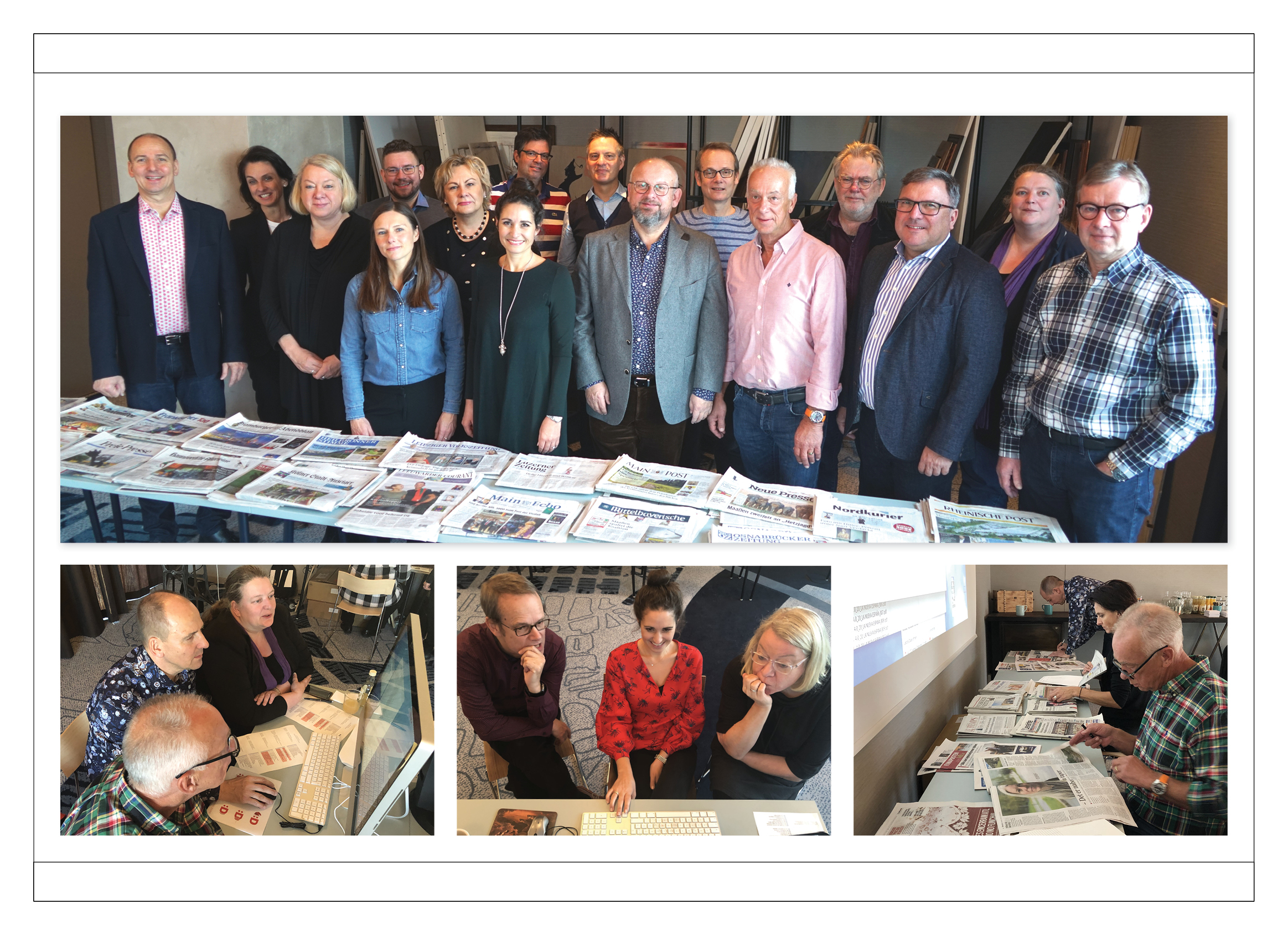 Die Jury des 20. European Newspaper Award (Bild oben, von links)
Die Jury des 20. European Newspaper Award (Bild oben, von links)
– Dirk Steininger, Art-Director, Stuttgarter Zeitung, D
– Marianne Bahl, Art-Director, Børsen, DK
– Marianne Hartz, Art-Director, Lebensmittel Zeitung, D
– Tanja Starkowski, Bildredakteurin, St. Galler Tagblatt, CH
– Björn Heselius, Principal Designer, Nitor, FIN
– Annette Milz, Chefredakteurin MediumMagazin, D
– Marco Grieco, Art-Director, Expresso, P
– Regina Baierl, Art-Director, Handelsblatt, D
– Søren Nyeland, Art-Director, Politiken, DK
– Prof. Dr. Martin Zimper, ZHdK/Cast, CH
– Martin Huisman, Art-Director, Het Nieuwsblad, B
– Walter Jensen, Art-Director, Bergens Tidende, N
– Theo Dersjant, Director Fontys School of Journalism, NL
– Andreas Kemper, Mitglied der Chefredaktion, Main-Post, D
– Alie Veenhuizen, Art-Director, Leeuwarder Courant, NL
– Prof. Joachim Blum, Media-Consultant, D
Mitglieder der Jury sind von der Bewertung der eigenen Arbeit ausgeschlossen.
Die Jury arbeitete in fünf Gruppen. Zwei Gruppen haben die Einreichungen in Online-Kategorien bewertet.
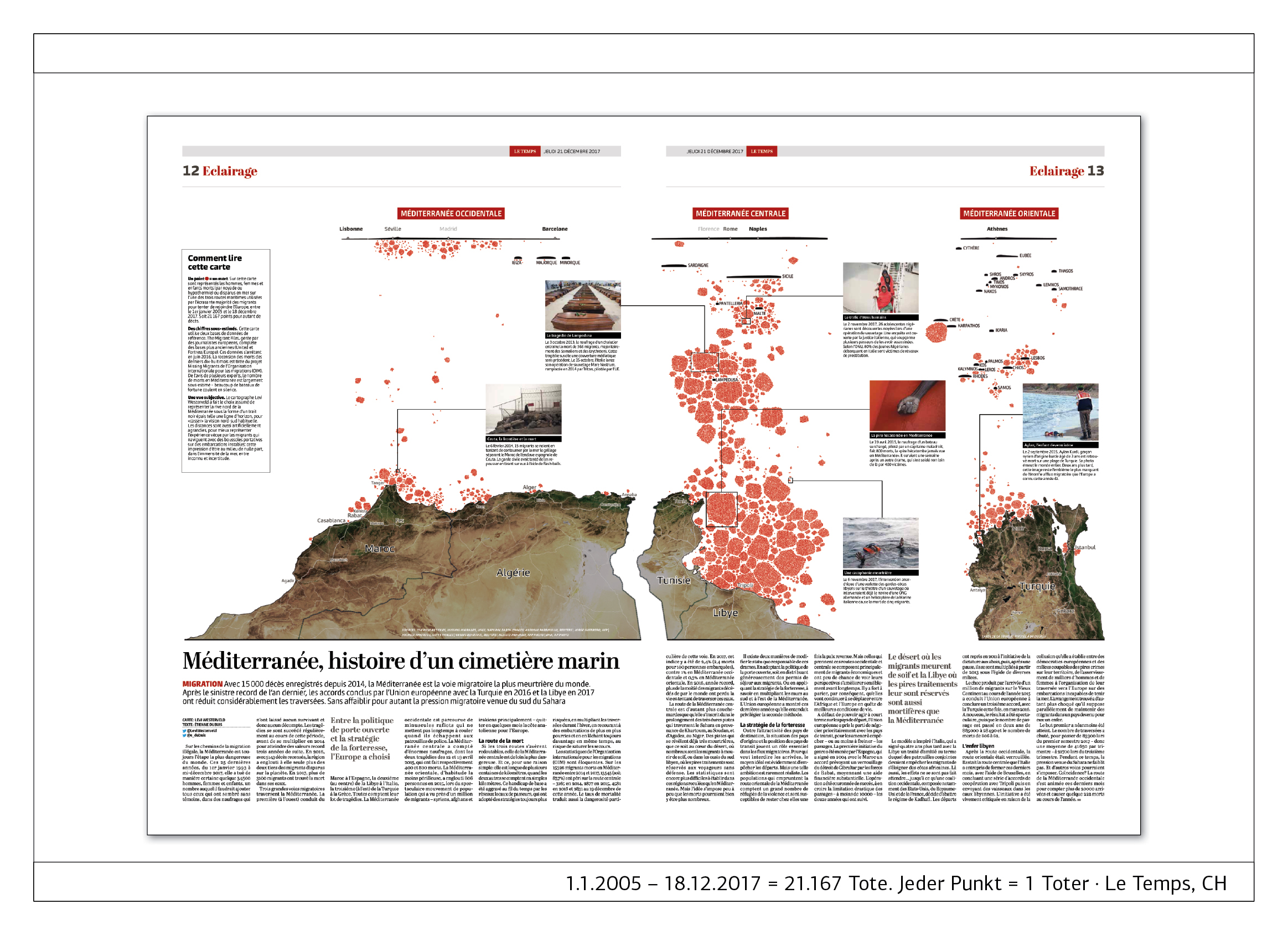
Print: Le Temps, Schweiz. Die Zeitung veröffentlichte eine Doppelseite mit 21.167 roten Punkten. Die Überschrift lautet sinngemäß “Mittelmeer, Geschichte eines maritimen Friedhofs”. Die roten Punkte zeigen, wo zwischen dem 1.1.2005 und dem 18.12.2017 Flüchtlinge im Mittelmeer ums Leben gekommen sind. Es sind drei Schwerpunkte: An der Straße von Gibraltar, vor der Küste Tunesiens und Lybiens und zwischen der Türkei und Griechenland. Es werden jeweils Ausschnitte gezeigt, nicht das gesamte Mittelmeer.
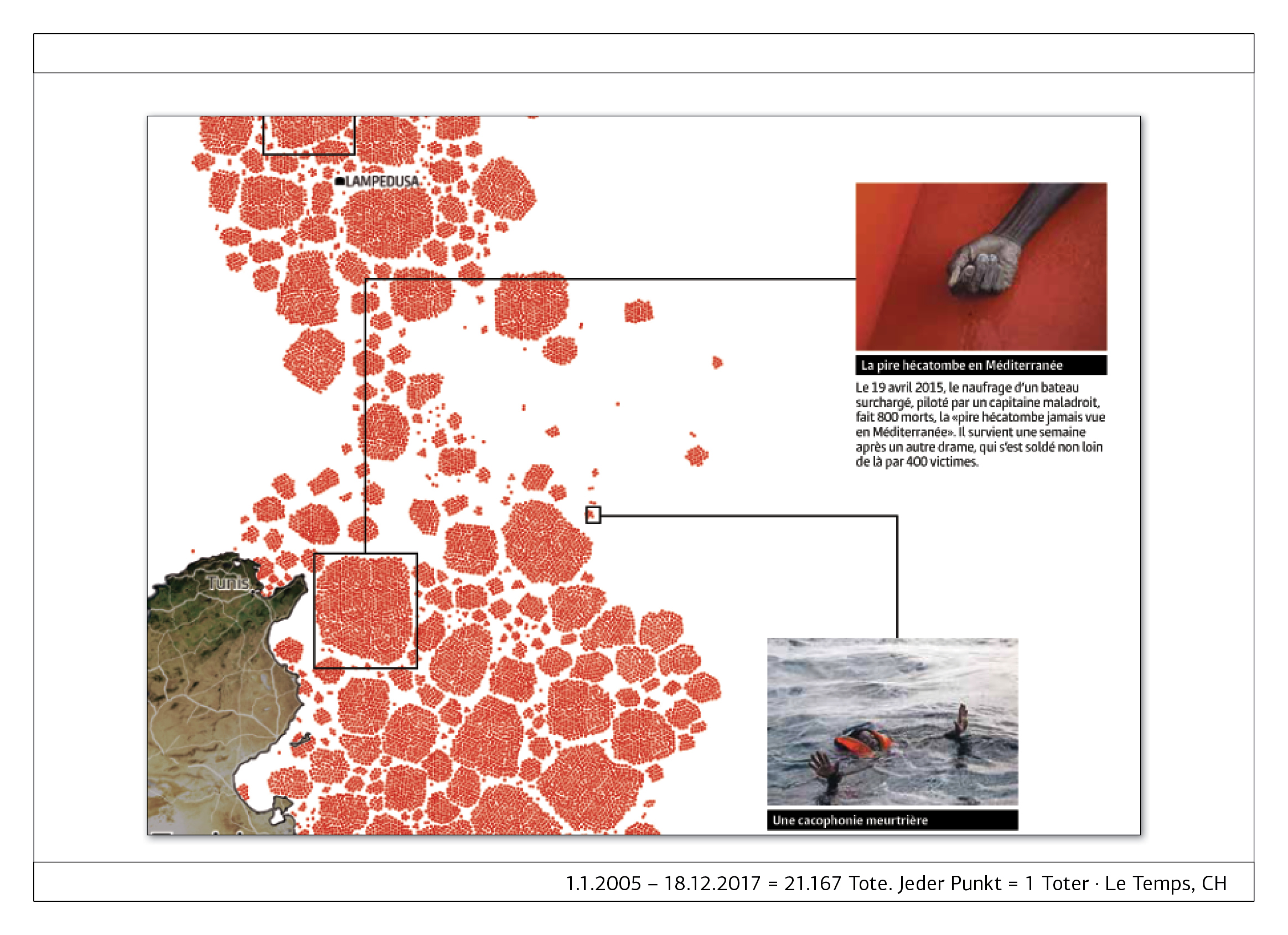
Le Temps, CH. Beispiel für Flüchtlings-Berichterstattung Print, Detailansicht. Jeder rote Punkt symbolisiert einen Toten. Es sind 21.167.
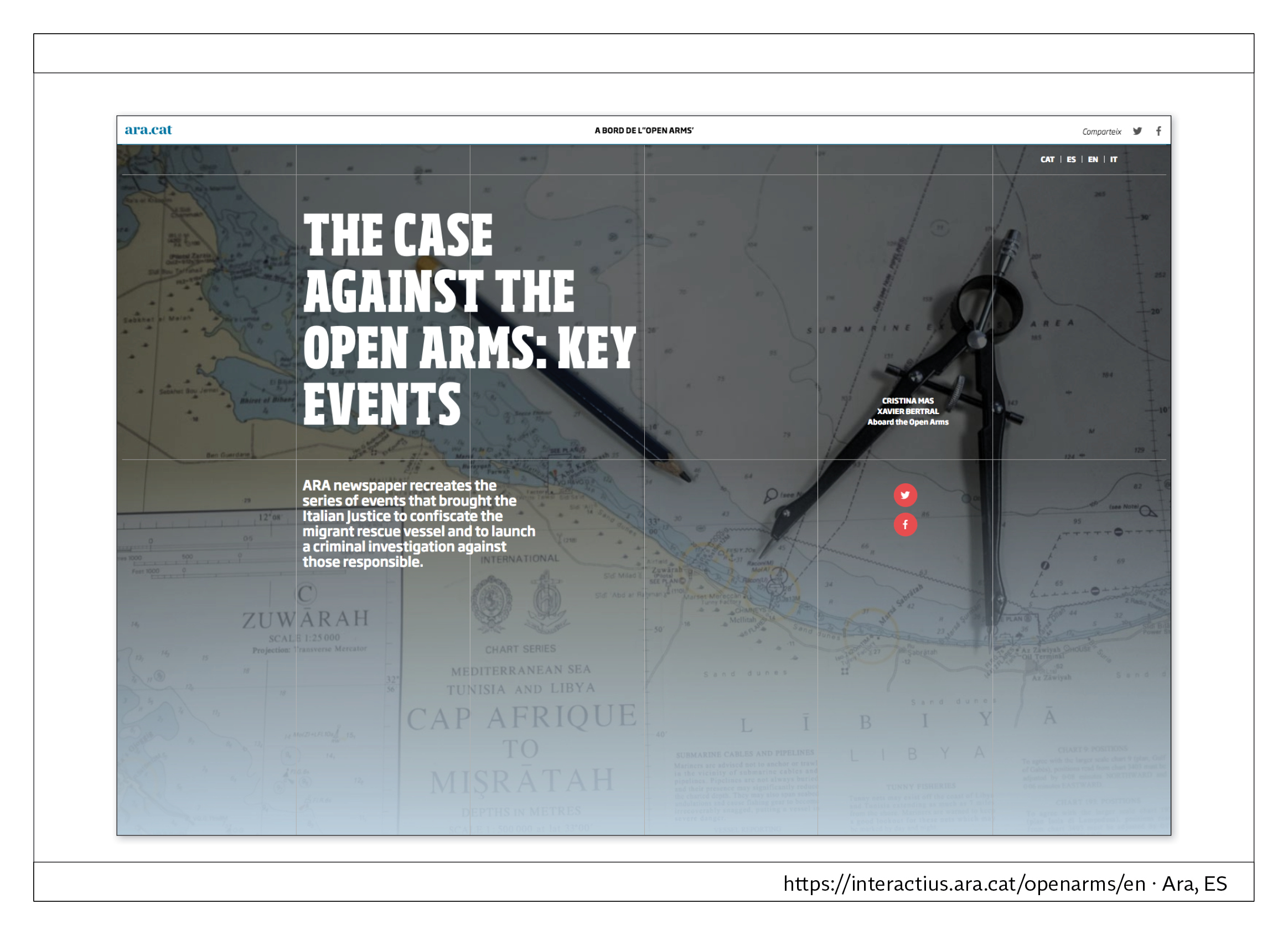
Online: Ara, Spanien. Das Verfahren gegen die ‘Open Arms’: Schlüsselereignisse. Die in Barcelona erscheinende Zeitung ARA stellt in einer Multimedia-Story die Ereignisse dar, die die italienische Justiz veranlassten, das Rettungsschiff „Open Arms“ zu konfiszieren und ein Ermittlungsverfahren gegen die Verantwortlichen einzuleiten. Während einer Rettungsaktion vor der Lybischen Küste hatte die Zeitung ein Team von Reportern an Bord. Die Story finden Sie HIER.
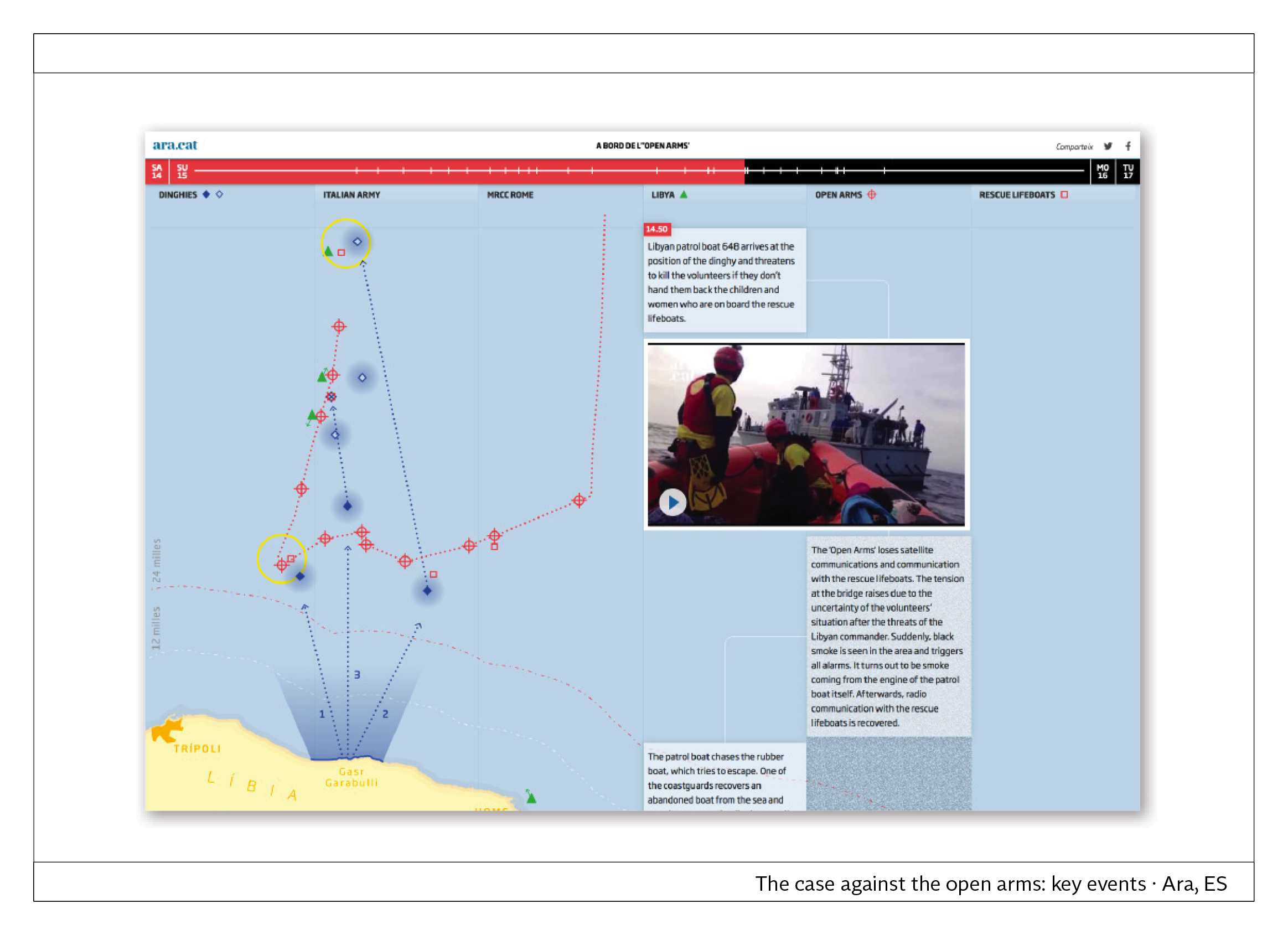
Online: Ara, Spanien. Das Geschehen wird anhand einer Seekarte visualisiert, auf der man sehen kann, wo sich Flüchtlingsboote und das Rettungsschiff befinden. Fotos und kurze Filme geben einen Eindruck vom Geschehen. Die Texte sind mit Uhrzeiten versehen, damit der Leser verfolgen kann, was in welcher Reihenfolge geschehen ist. Oben ist eine Zeitschiene, die sich mit dem Scrollen mehr und mehr rot verfärbt. Dadurch weiß der Leser, an welcher Stelle der Rettungsaktion er sich befindet.
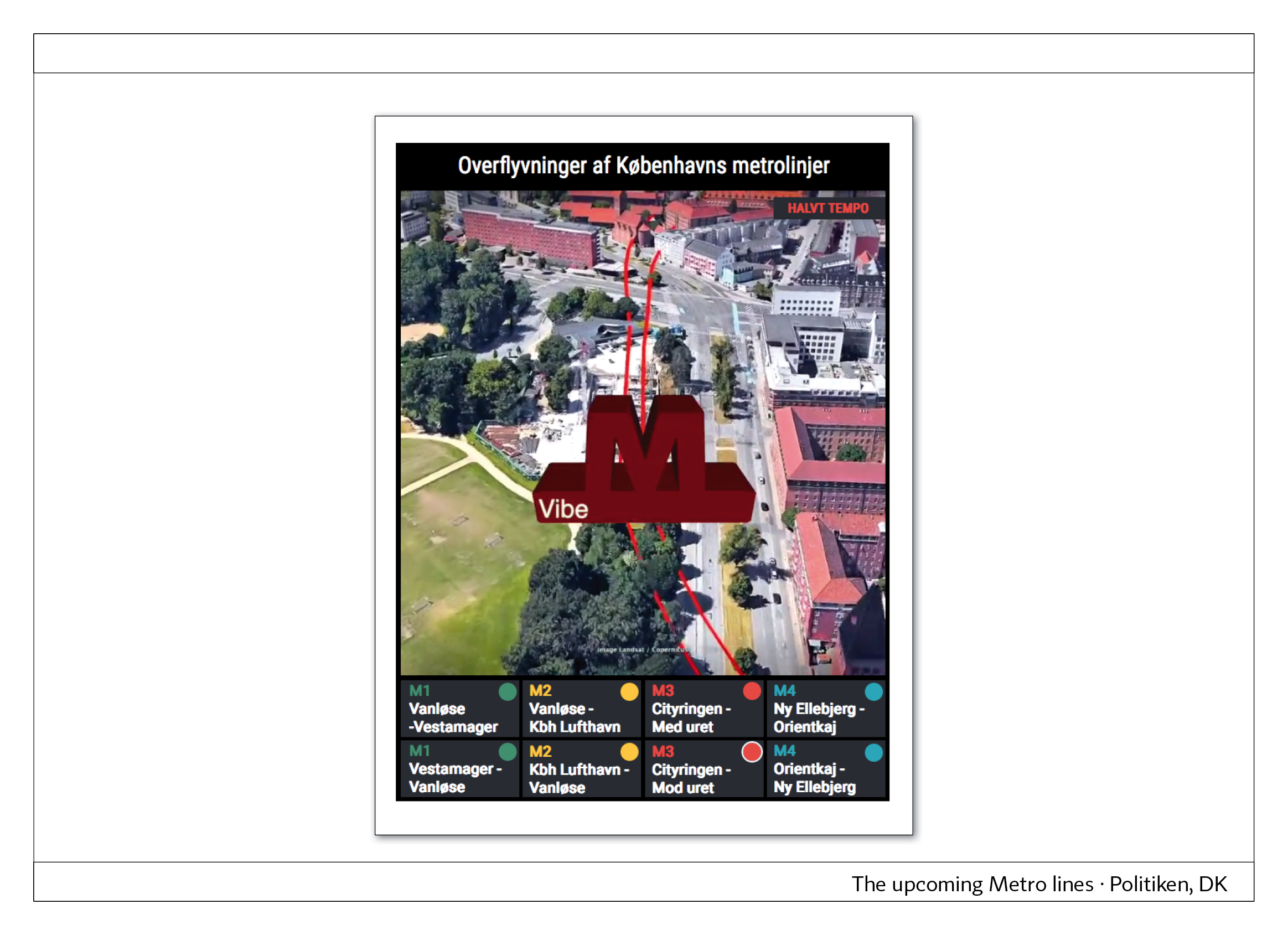
Politiken, DK: Die Zeitung zeigt sehr anschaulich eine geplante U-Bahn-Strecke. Sehr interessantes Projekt, angesiedelt zwischen Film und animierter Infografik. Das Projekt finden Sie HIER.
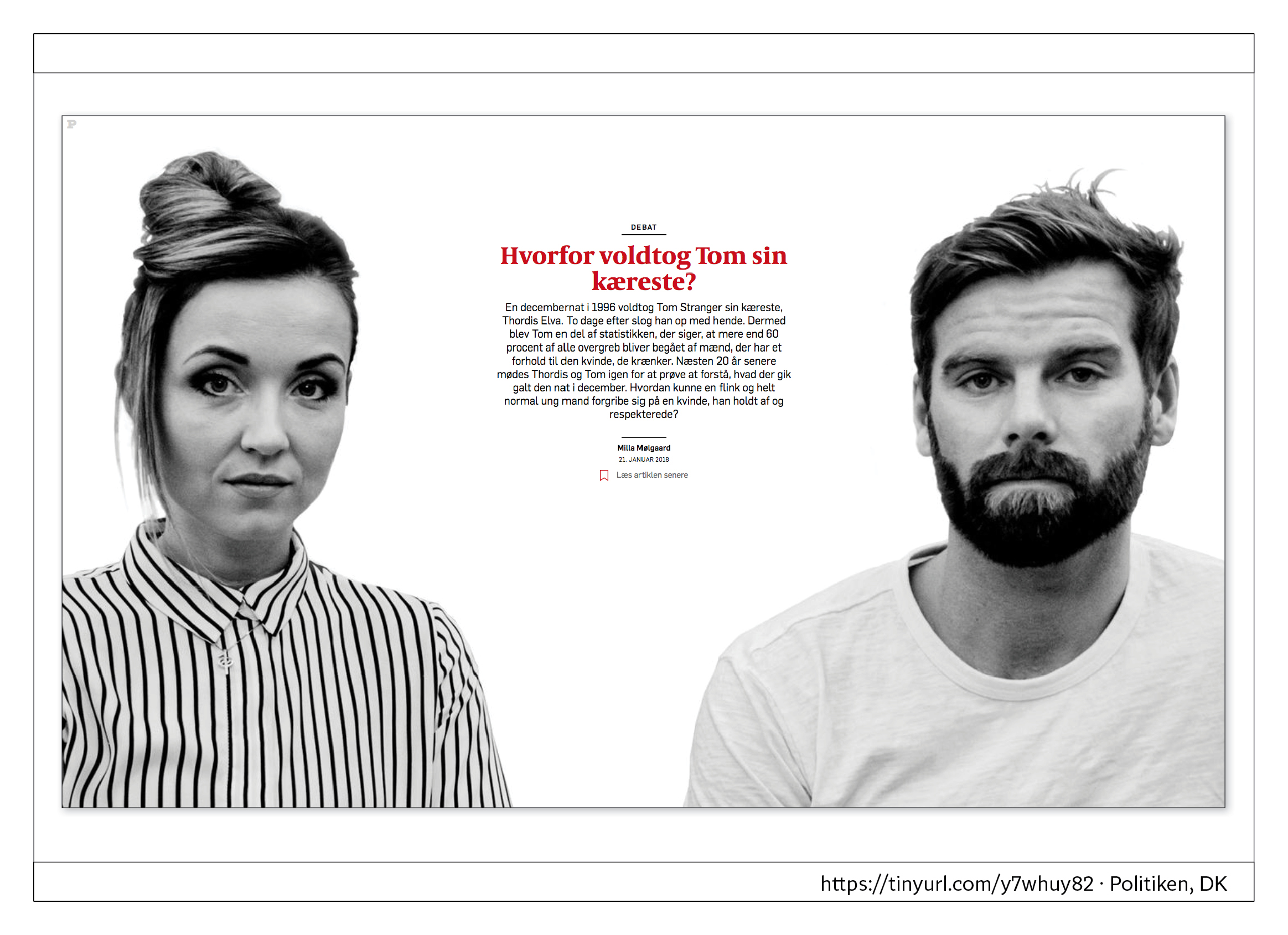
Politiken, DK: Warum hat Tom seine Freundin Thordis vergewaltigt? Fast 20 Jahre nach der Vergewaltigung treffen sich Thordis und Tom erneut, um zu verstehen, was in dieser Nacht im Dezember schiefgegangen ist. Wie konnte ein ganz normaler junger Mann gegenüber der Frau, die er liebte und respektierte, so handeln? Die Geschichte läuft in zwei parallel verlaufenden Spuren. Man kann zwischen den beiden Personen hin- und her wechseln. Die Story finden Sie HIER.
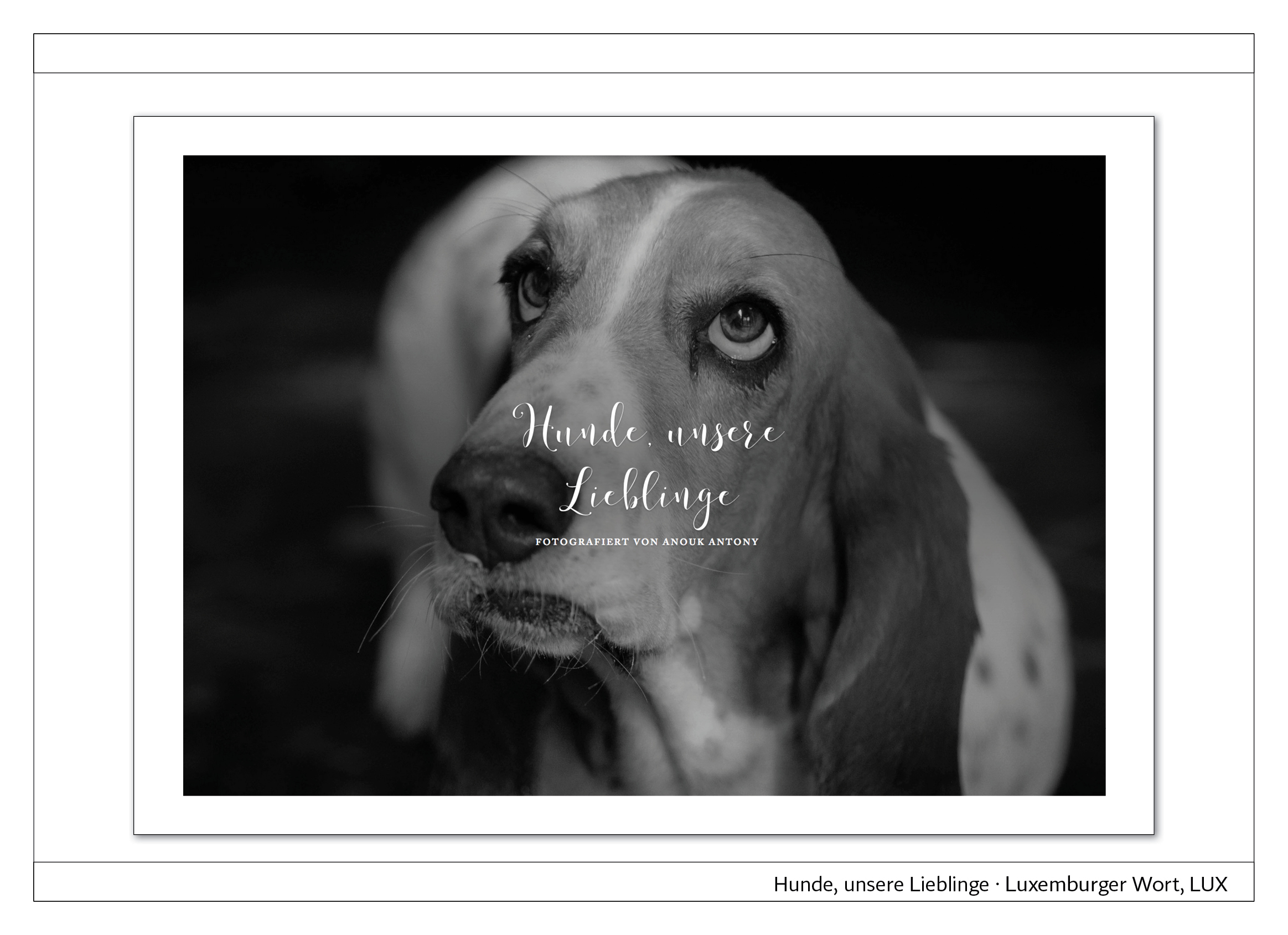
Luxemburger Wort, LUX: Hunde, unsere Lieblinge. Die Zeitung bietet einen enstspannten Blick auf Hunde. Es werden Schwarzweiß-Fotos eingesetzt, fotografiert von Anouk Antony. Die Perspektive wechselt, es gibt Totalen und Nahaufnahmen. Das Projekt wurde mit der Software Adobe Spark realisiert. Die Arbeit mit überlappenden Fotos auf verschiedenen Ebenen ist interessant. Das Projekt finden Sie HIER.
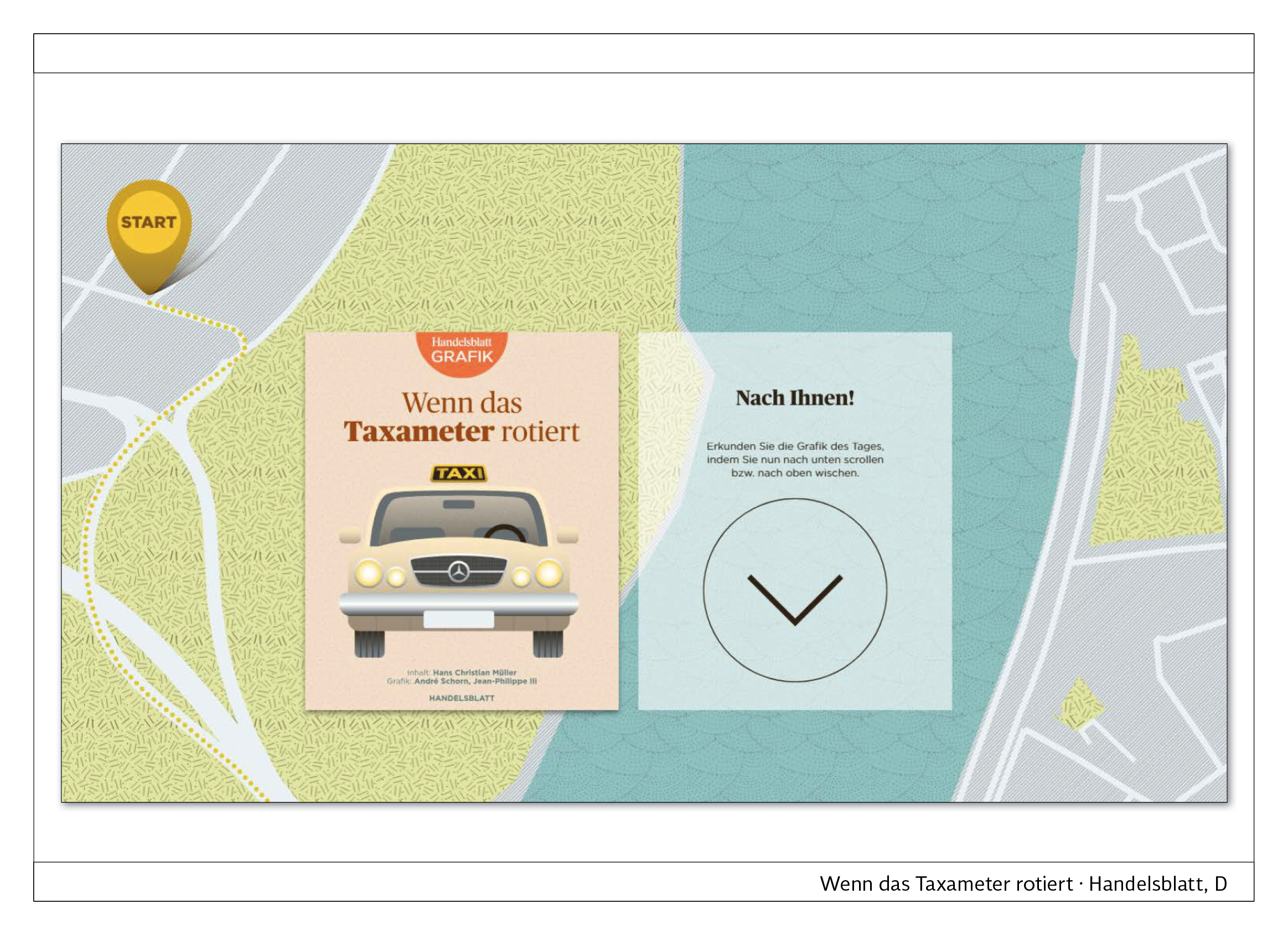
Handelsblatt, D: Wenn das Taxameter rotiert. Die Zeitung gibt anhand von kleinen animierten Infografiken einen Überblick über den Taximarkt in Deutschland. Das Projekt zeigt beispielhaft, wie man komplexe Themen für das Smartphone aufbereitet. Der Trick: Statt einer komplexen Infografik viele kleine einsetzen. Das Projekt finden Sie HIER.
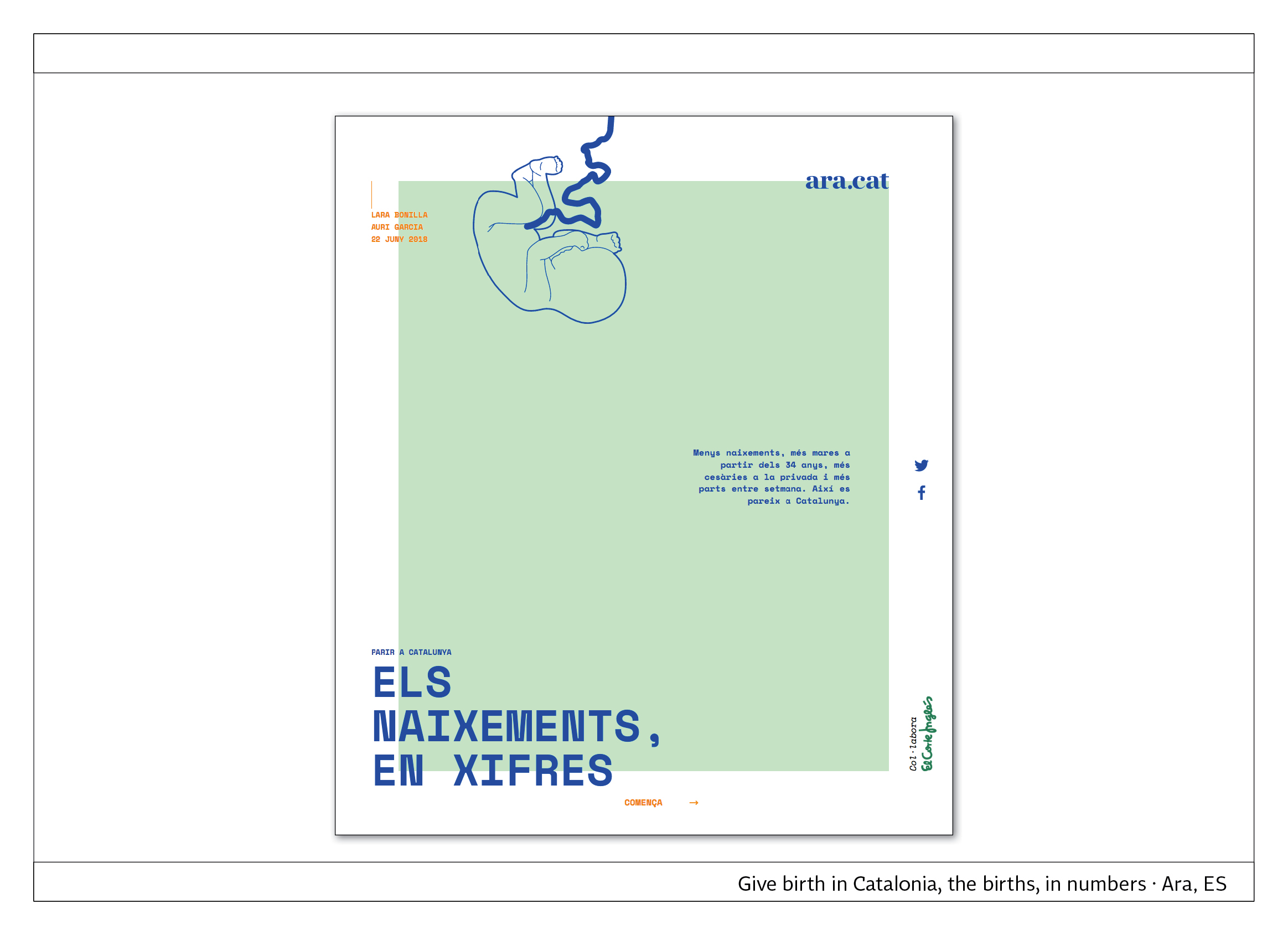
Ara, ES: Geburten in Zahlen. Anhand von 19 animierten Infografiken wird über die Geburtenrate in Katalonien berichet. Beispiele: 1986 waren die Mütter bei der Geburt ihres ersten Kindes im Durchschnitt 26,1 Jahre alt, 2016 sind sie 30,8 Jahre alt. 69 Prozent der Geburten erfolgten in öffentlichen Kiniken, 30,5 Prozent in Privat-Kliniken. Die Infografiken funktionieren sowohl auf dem Bildschirm wie auf dem Smartphone sehr gut. Die Story finden Sie HIER.
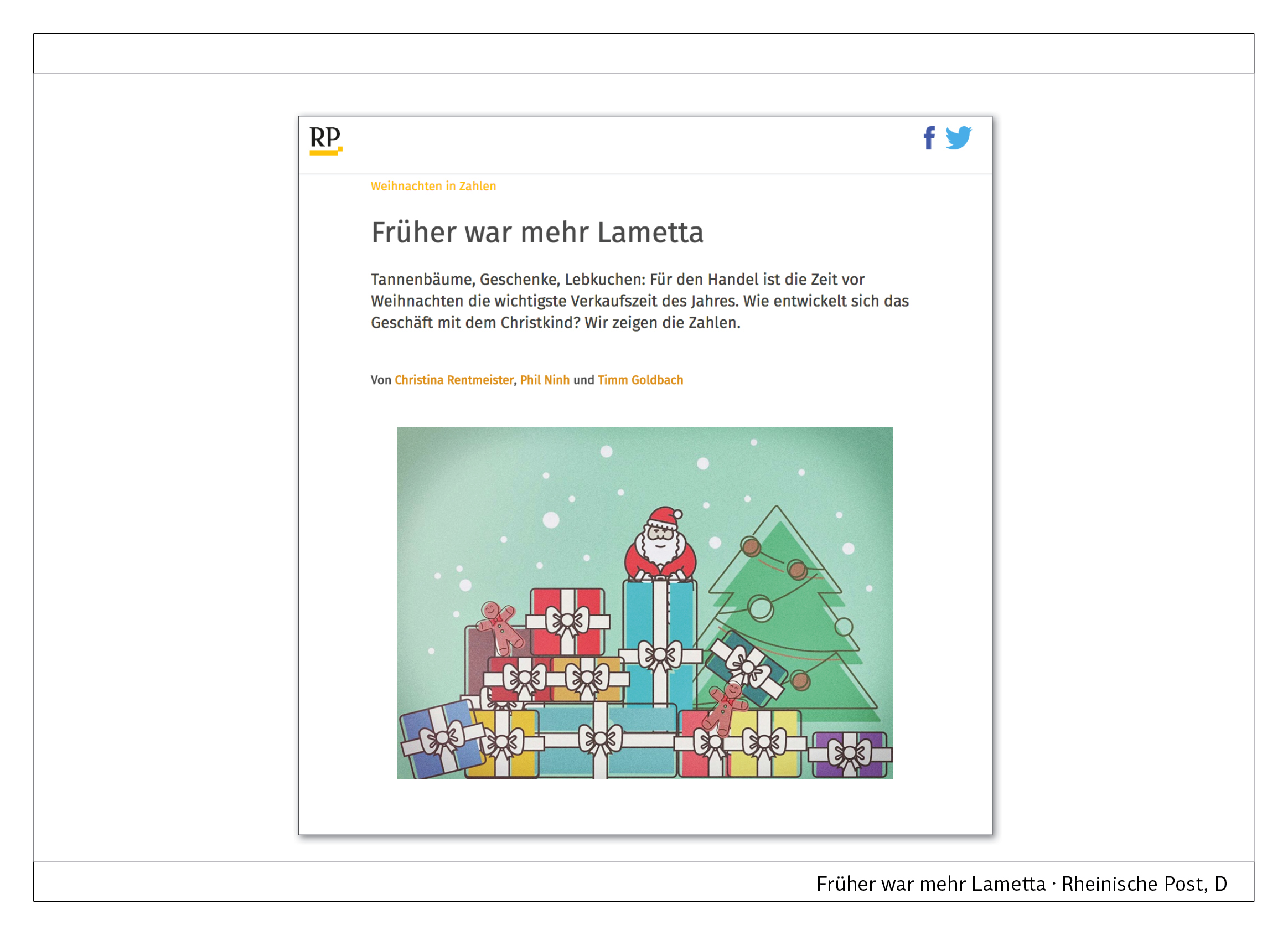
Rheinische Post, D: Früher war mehr Lametta. Im Vorspann heißt es: “Tannenbäume, Geschenke, Lebkuchen: Für den Handel ist die Zeit vor Weihnachten die wichtigste Verkaufszeit des Jahres. Wie entwickelt sich das Geschäft mit dem Christkind? Wir zeigen die Zahlen.” Die Story bietet eine interessante Kombination aus animierten Infografiken und passend dazu platzierten Erläuterungen. Zum Projekt geht es HIER.
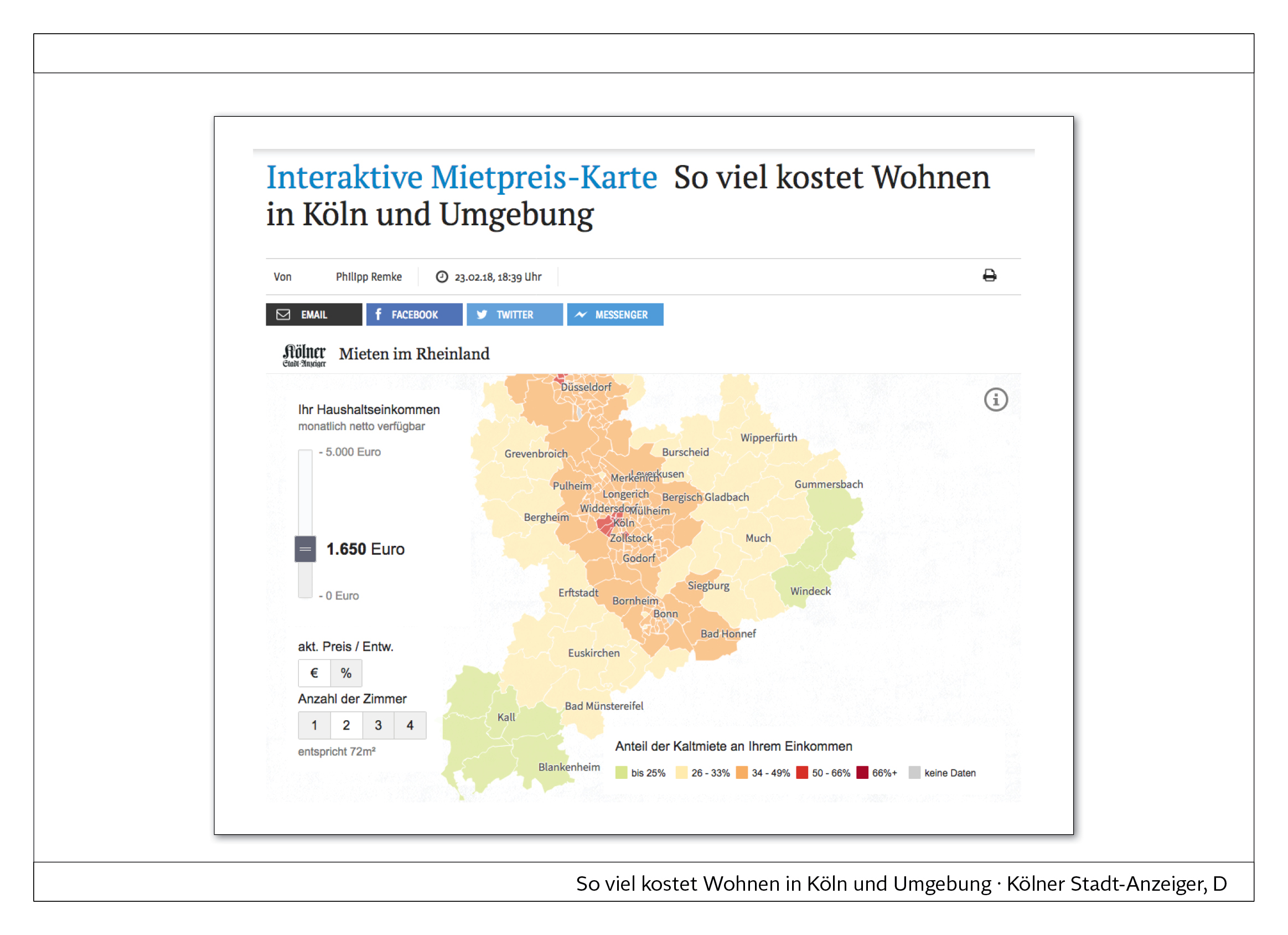
Kölner-Stadt-Anzeiger, D: Interaktive Mietpreis-Karte. So viel kostet Wohnen in Köln und Umgebung. Jury-Mitglied Björn Heselius schreibt: “Die Daten werden intelligent genutzt und Inhalte sehr gut visualisiert. Die Bedürfnisse und Neugier der Nutzer stehen an erster Stelle. Die Navigation ist intuitiv und sehr gut.” Zum Projekt: HIER.
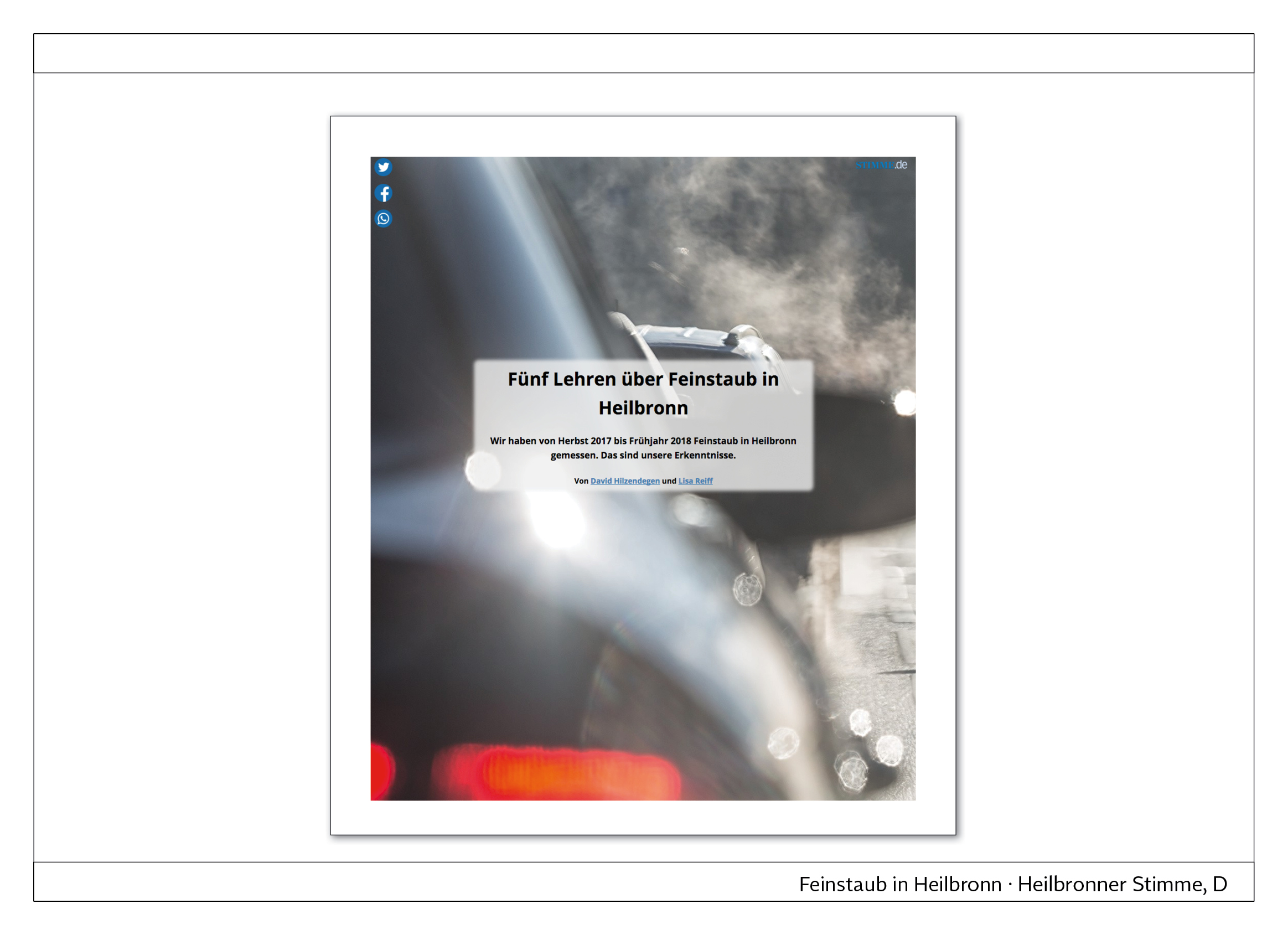
Heilbronner Stimme, D: Fünf Lehren über Feinstaub in Heilbronn. Für das Projekt wurden selbst gebaute Geräte zur Feinstaubmessung verwendet, die in der Stadt verteilt wurden. Die Zeitung wollte den offiziellen Messstationen keine Konkurrenz machen, aber Informationen über zeitlich und örtlich auftretende Feinstaubquellen sammeln. Die Story ist in fünf Punkte gegliedert. Diese beiden fallen besonders auf: 1. Am Wochenanfang gibt es einen deutlichen Peak: Die Luft ist sehr mit Feinstaub belastet, zum Wochenende wird sie besser. 2. Holzofen an, Feinstaubwerte hoch. Auch in verkehrsarmen Vorstädten kann man hohe Feinstaub-Konzentrationen messen, nämlich wenn offene Kamine betrieben werden. Insgesamt sehr klare, übersichtliche Gestaltung. Gutes Verhätnis von Text und Abbildungen, gute Gliederung. Zum Projekt geht es HIER.

Stuttgarter Nachrichten, Stuttgarter Zeitung, D: Feinstaubradar. Im Vorspann heißt es: “Mit dem Feinstaubradar können Bürgerinnen und Bürger in der ganzen Region Stuttgart stündlich überprüfen, wie viel Feinstaub in der Luft ist – vor ihrer Haustür.” Die Story wird begleitet von vier Artikeln, die Hintergründe liefern: 1. So messen wir Feinstaub. Fast 750 Sensoren liefern Daten – wir bereiten sie auf. 2. 45 Ideen für das Feinstaubradar. 3. So basteln Sie Ihr eigenes Messgerät. 4. Feinstaub – der Faktencheck. Was ist Feinstaub, Wo kommt er her? Was kann man tun? Insgesamt ein sehr aufwändiges Projekt, das permanent fortgesetzt wird. Herausragender Service für die Leserinnen und Leser. Die Story finden Sie HIER.
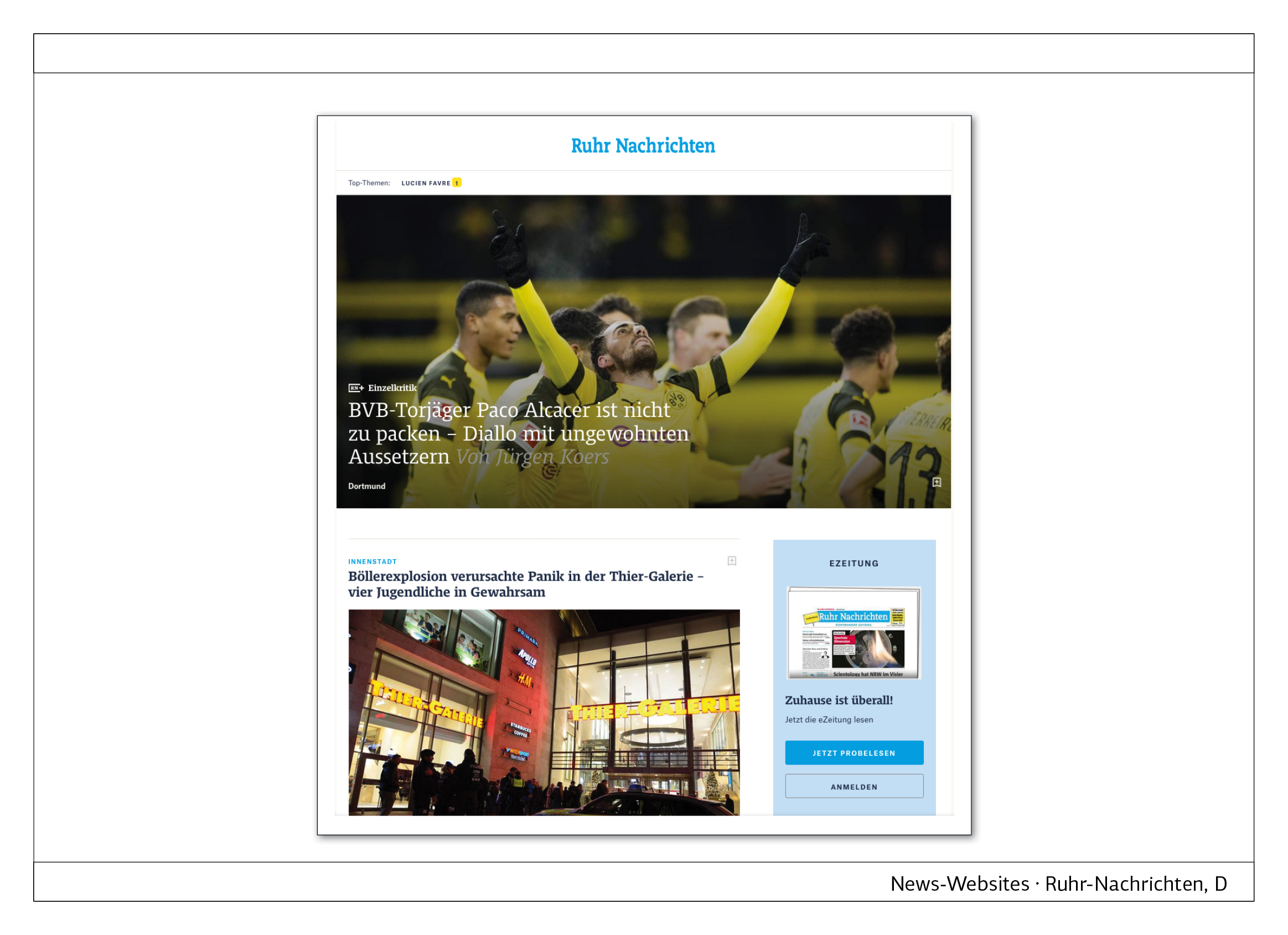
Ruhr-Nachrichten, D: Die Website wurde neugestaltet und ist sowohl für das Smartphone wie für den Bildschirm sehr gut geeignet. Die Navigation ist einfach und intuitiv. Als Grundschrift wird eine Schrift mit Serifen eingesetzt. Das garantiert eine gute Lesbarkeit und einen seriösen Gesamteindruck. Wenn man die Website auf dem Computer nutzt, ist die oberste Story sehr gut als Coverstory gekennzeichnet, denn das Bild wird über die volle Breite des Bildschirms geführt und die Überschrift steht im Bild. Ein sehr leserfreundliches Detail ist die Angabe der Lesedauer am Anfang des Artikels. https://www.ruhrnachrichten.de/
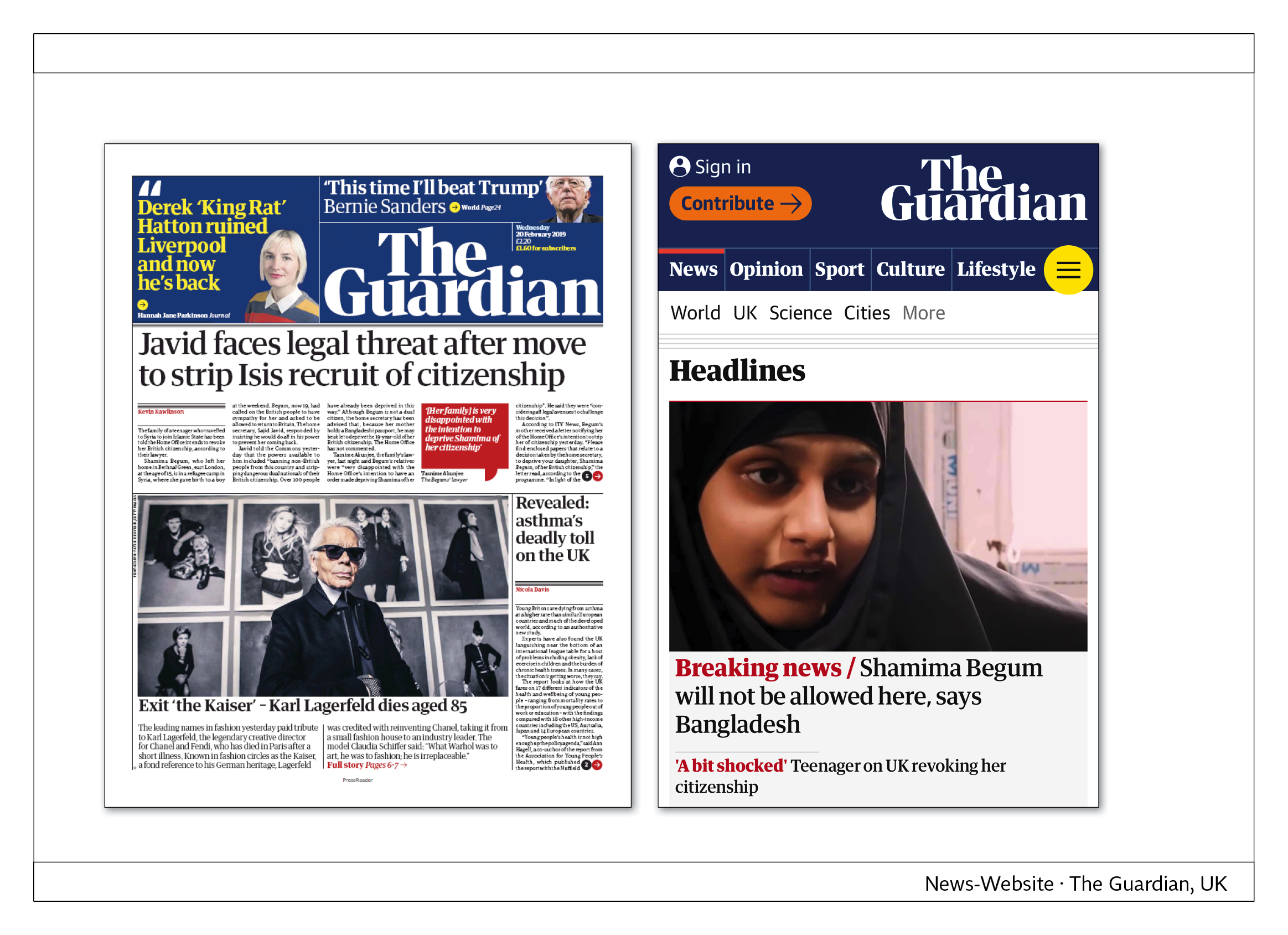
The Guardian, GB: Diese Website ist nicht im Wettbewerb. Es ist aber ein sehr gutes Beispiel für crossmediale Typografie. Links ist die Titelseite Print, rechts die Startseite Online: Die Farben und die Typografie sind identisch. Der Guardian setzt schon seit einigen Jahren eine eigene Hausschrift ein, die für ein unverwechselbares Erscheinungsbild sorgt. https://www.theguardian.com/international
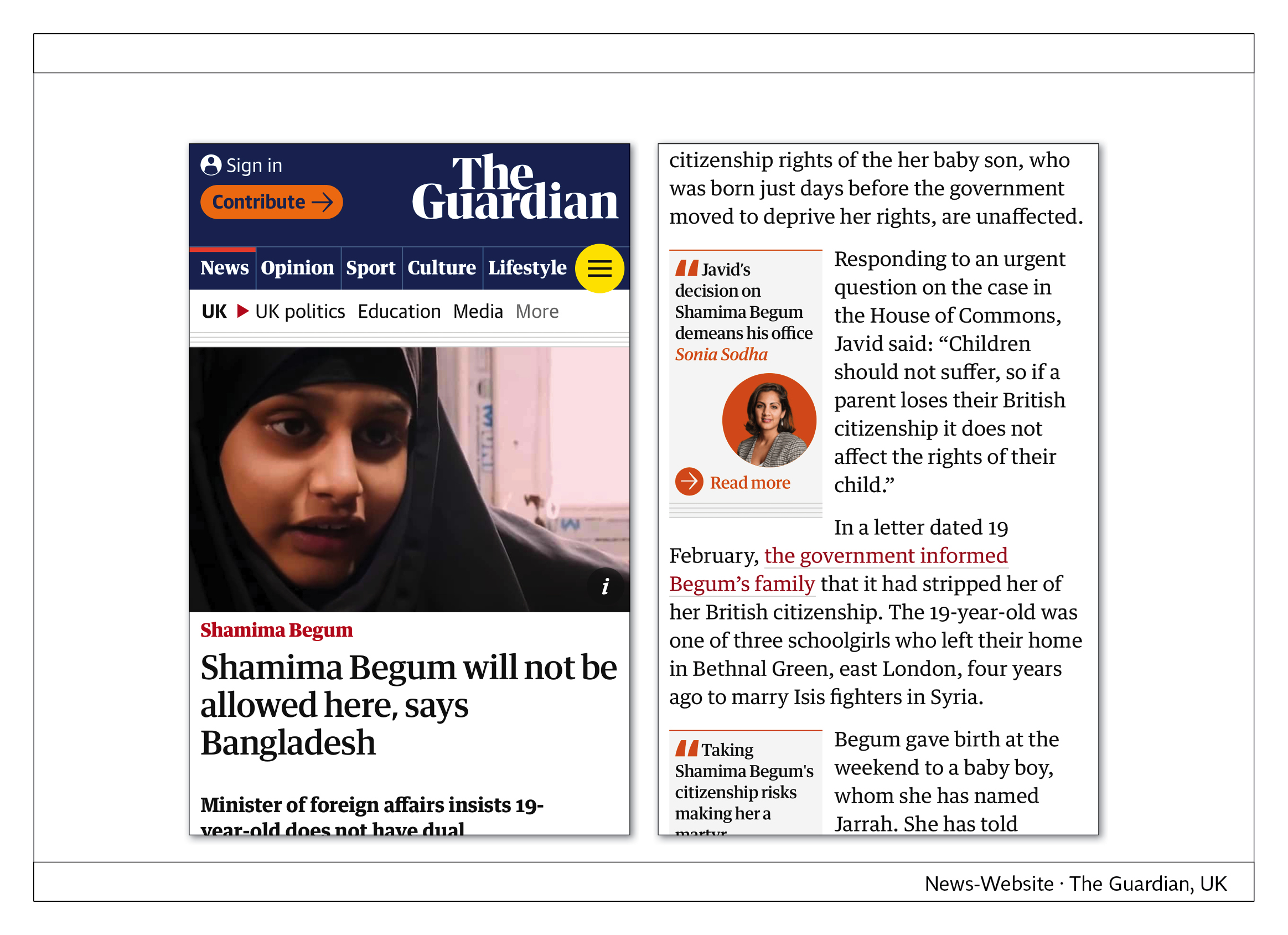
The Guardian, GB: Ein Artikel startet normalerweise mit einem Bild, wie hier gezeigt. Danach folgt die Überschrift mit einem Stichwort. Zwei Featueres sind besonders interessant: 1. Auf dem Smartphone hat der Text links eingeschobene Zitate, die oft zu Hintergrund-Themen führen. Der Grundtext läuft rechts vorbei. In englischer Sprache ist das kein Problem, denn die Worte sind viel kürzer als beispielsweise im Deutschen 2. Auf dem Smartphone kann man die Grundschriftgröße stufenlos verändern und an seine Bedürfnisse anpassen. Das ist bei den meisten News-Websites nicht möglich. https://www.theguardian.com/international
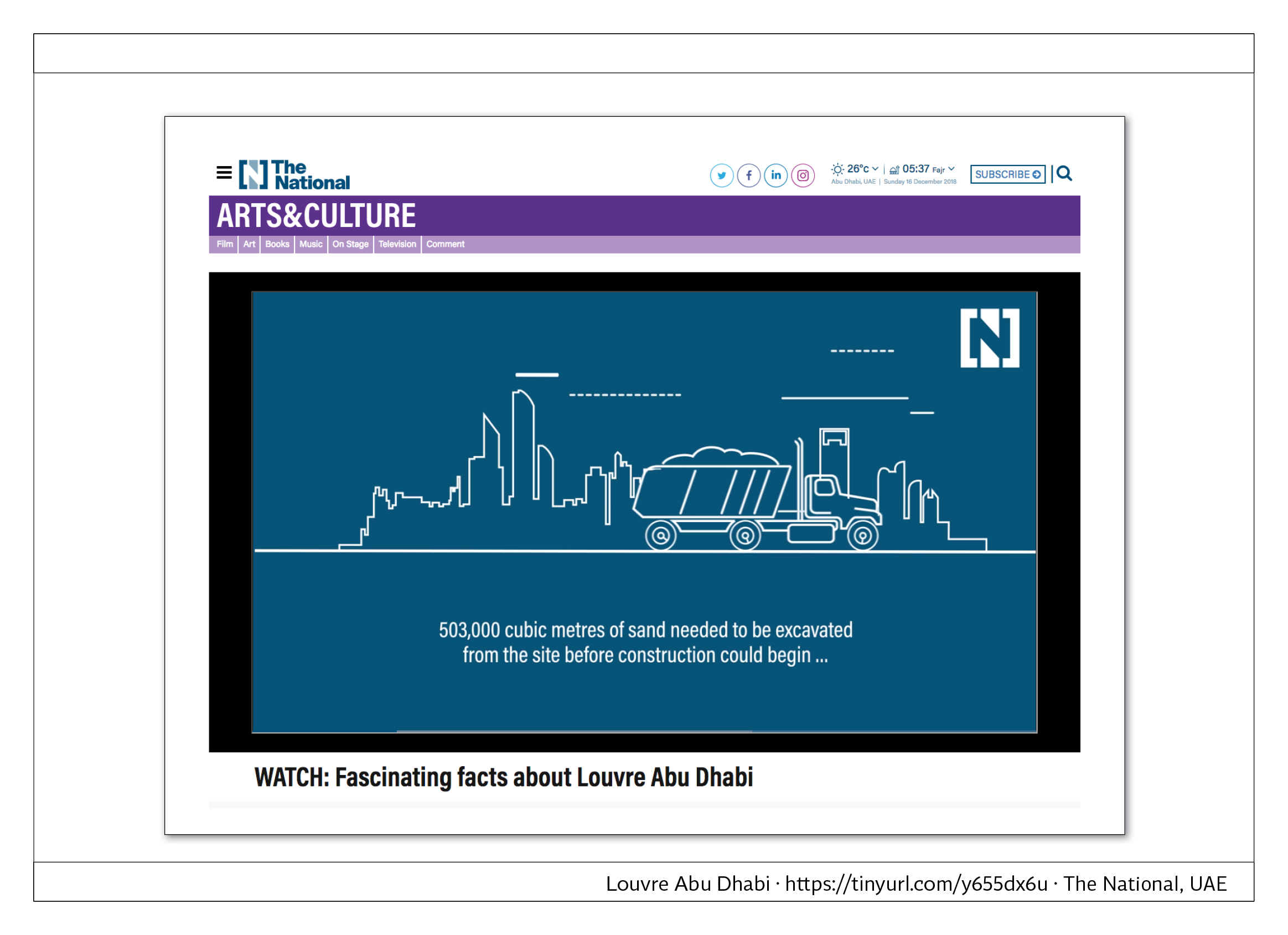
The National, UAE: Faszinierende Fakten über den Louvre Abu Dhabi. Die Zeitung aus den Vereinigten Arabischen Emiraten ist auf den European Newspaper Award aufmerksam geworden und es spricht nichts dagegen, Zeitungen außerhalb Europas teilnehmen zu lassen. Die Jury meinte zu dem Projekt: “Hübscher Animations-Stil. Gute Kombination von Zeichnung und Musik.” In der Tat kommt der Trickfilm ohne Sprache aus. LINK.

Sächsische Zeitung, D: Die kleine Deutsche Einheit. Die Geschichte beginnt im Jahr 1964: Ein Luftballon mit einer Postkarte überquert die innerdeutsche Grenze. Aus einer Brieffreundschaft zwischen zwei Mädchen wird ein Beziehungsgeflecht, das bis heute hält. Die Beteiligten werden interviewt und anhand von eigenen Fotos und von historischen Aufnahmen wird die Story erzählt. Es ist nicht nur die Geschichte von zwei Personen, sondern der kleinen Deutschen Einheit, wie es in der Überschrift ganz richtig heißt, denn historische Ereignisse werden in das Geschehen eingeflochten. Sehr gute Kombiantion aus Drohnenaufnahmen, gesprochenen Texten und authentischen Interview-Szenen. http://tinyurl.com/y22p755j
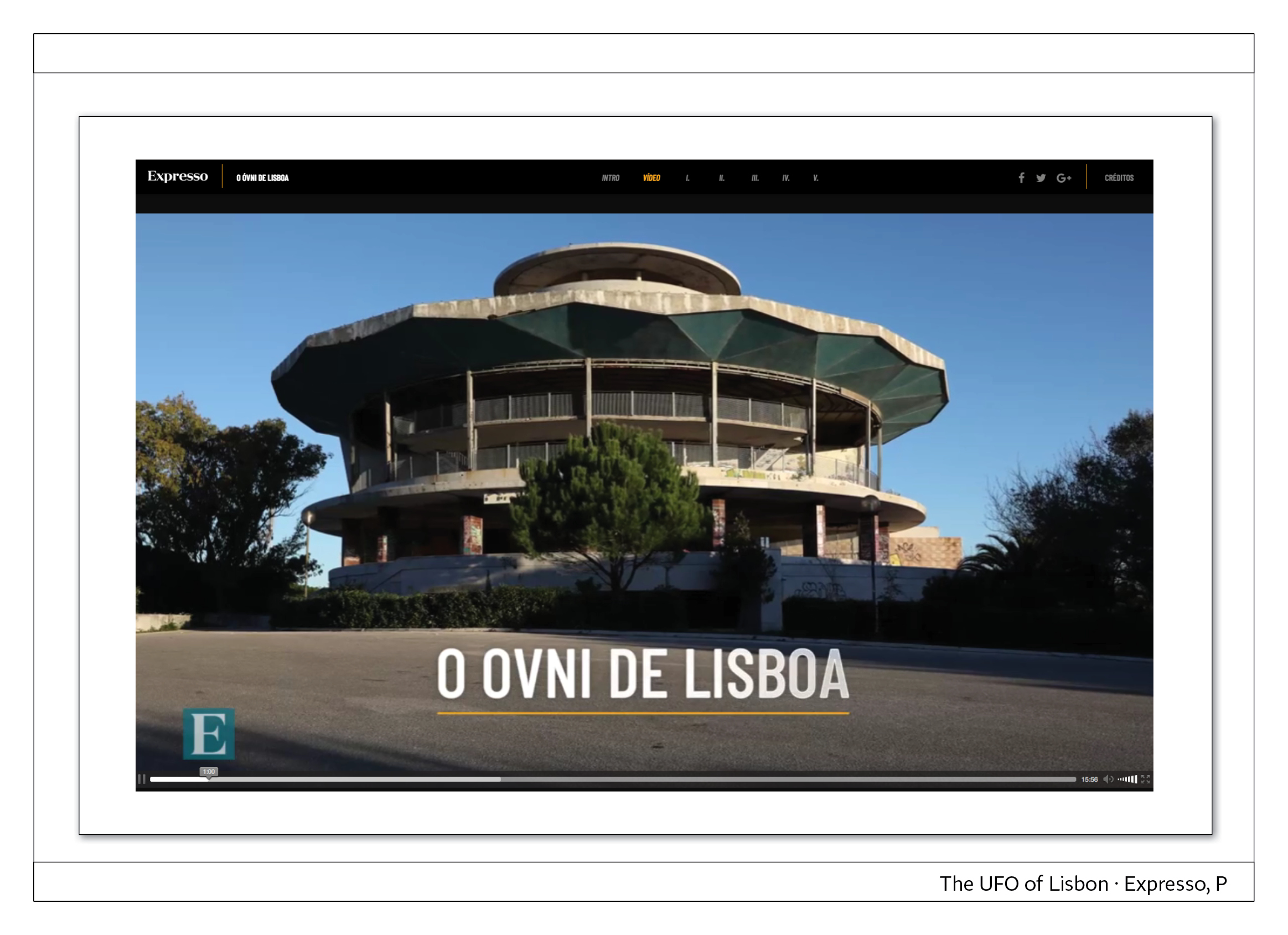
Expresso, P: Das UFO von Lissabon. Die Jury schreibt zu diesem Projekt: “Schöne Details beim Storytelling. Es wird das komplette Toolkit benutzt: 360-Grad-Videos, Drohnen, Zeitleiste, Fotos und Illustrationen. Man könnte annehmen, dass man es mit all diesen Werkzeugen übertreibt, aber die Bildsprache verbindet alles miteinander.” Zum Projekt geht es HIER.
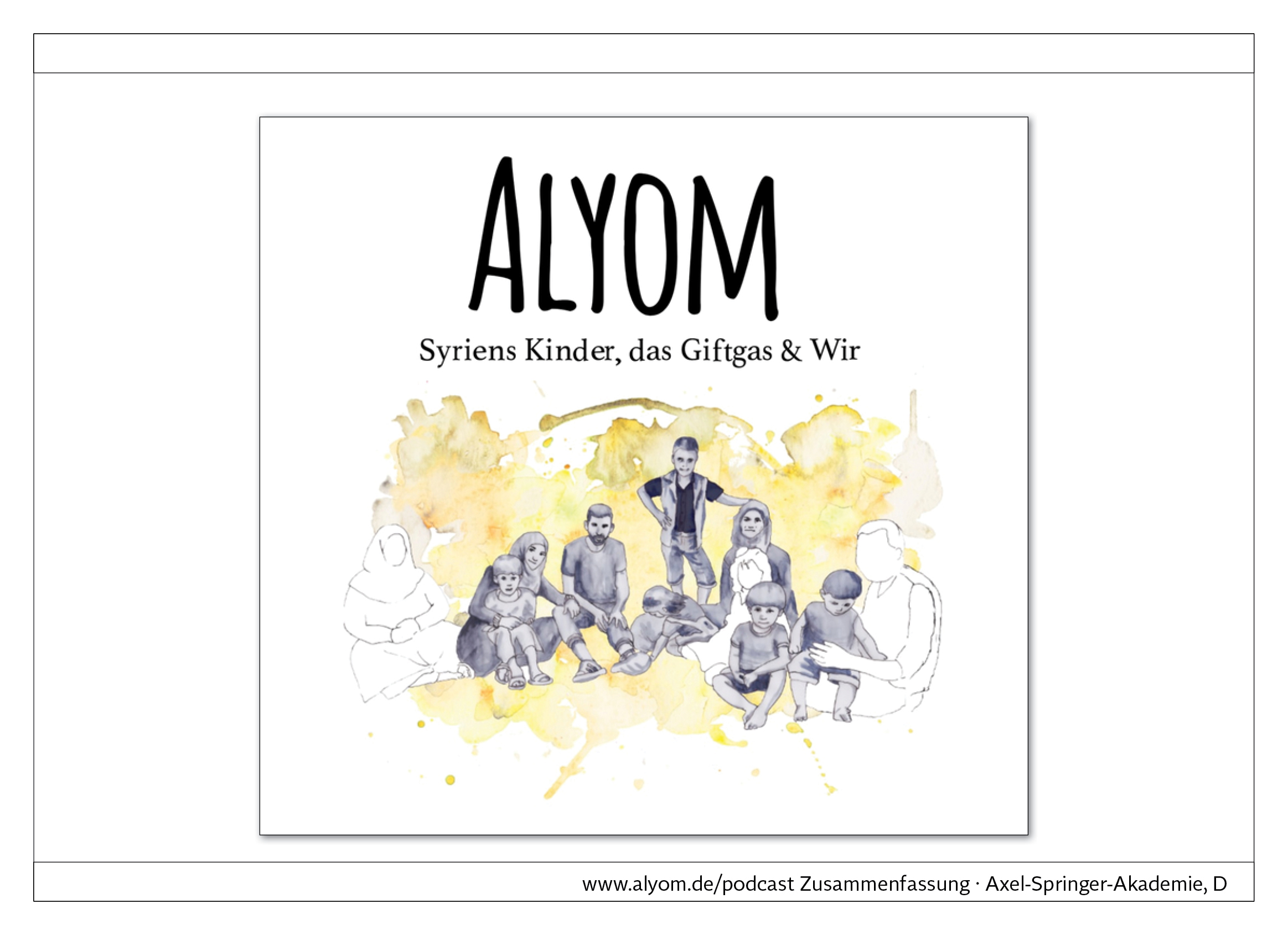
Axel-Springer-Akademie, D: Alyom. Syriens Kinder, Giftgas & Wir. Jurymitglied Professoer Joachim Blum schreibt dazu: „Jedes Jahr bin ich begeistert von den Projekten der Axel-Springer-Akademie. In diesem Jahr heißt es ‘Alyom – Syriens Kinder, das Giftgas & Wir’. Es ist einfach großartig. Zu hören sind neun eindringliche Audiobeiträge über den grauenvollen Giftgas-Einsatz in Syrien. Für ein internationales Publikum sind alle Audios zusätzlich auch in englischer Sprache mit englischen Begleittexten. Das ist vorbildlich.“ www.alyom.de/podcast/zusammenfassung
Kontakt
Norbert Küpper, Veranstalter des European Newspaper Award, Gutenbergstraße 4, 40670 Meerbusch, Telefon 0 21 59 91 16 15, Email nkuepper@newspaperaward.org
Der 20. European Newspaper Award hat 18 Kategorien. Es gibt wie immer Print- und Online-Kategorien. Hier werden ein paar beispielhafte Foto-Reportagen Print und Online aus dem 19. Wettbewerb vorgestellt. Den Call for Entries finden Sie hier: www.newspaperaward.org
Traditionell sind bei Foto-Reportagen skandinavische Zeitungen führend. Das sieht man auch bei den hier gezeigten Beispielen. In Skandinavien werden Text und Bild von jeher als gleichberechtigte Informationsträger gesehen. Im deutschen Sprachraum dominiert dagegen eher der Text. Die Situation hat sich in den letzten Jahren aber gebessert, denn wenn es um Multimedia-Reportagen geht, sind deutschsprachige Zeitungen mit sehr guten Beispielen im Wettbewerb vertreten.
Alle Preisträger des 19. European Newspaper Award finden Sie im Jahrbuch, das auf DVD oder USB-Stick erhältlich ist. Bestellung hier.

Die 18 Kategorien des European Newspaper Award. Rot markiert sind die Online-Kategorien

Politiken, DK. „Es wird ein …“ Mädchen oder Junge. In der kleinen Foto-Reportage werden vier Schwangere gezeigt, die gerade erfahren, ob es ein Junge oder ein Mädchen wird. Gratulation! Und: Eine Foto-Reportage kann tatsächlich nur aus wenigen Bildern bestehen. Wir sehen hier eine komplette Story, die überwiegend mit Bildern erzählt wird. Genau so wird die Foto-Reportage definiert.
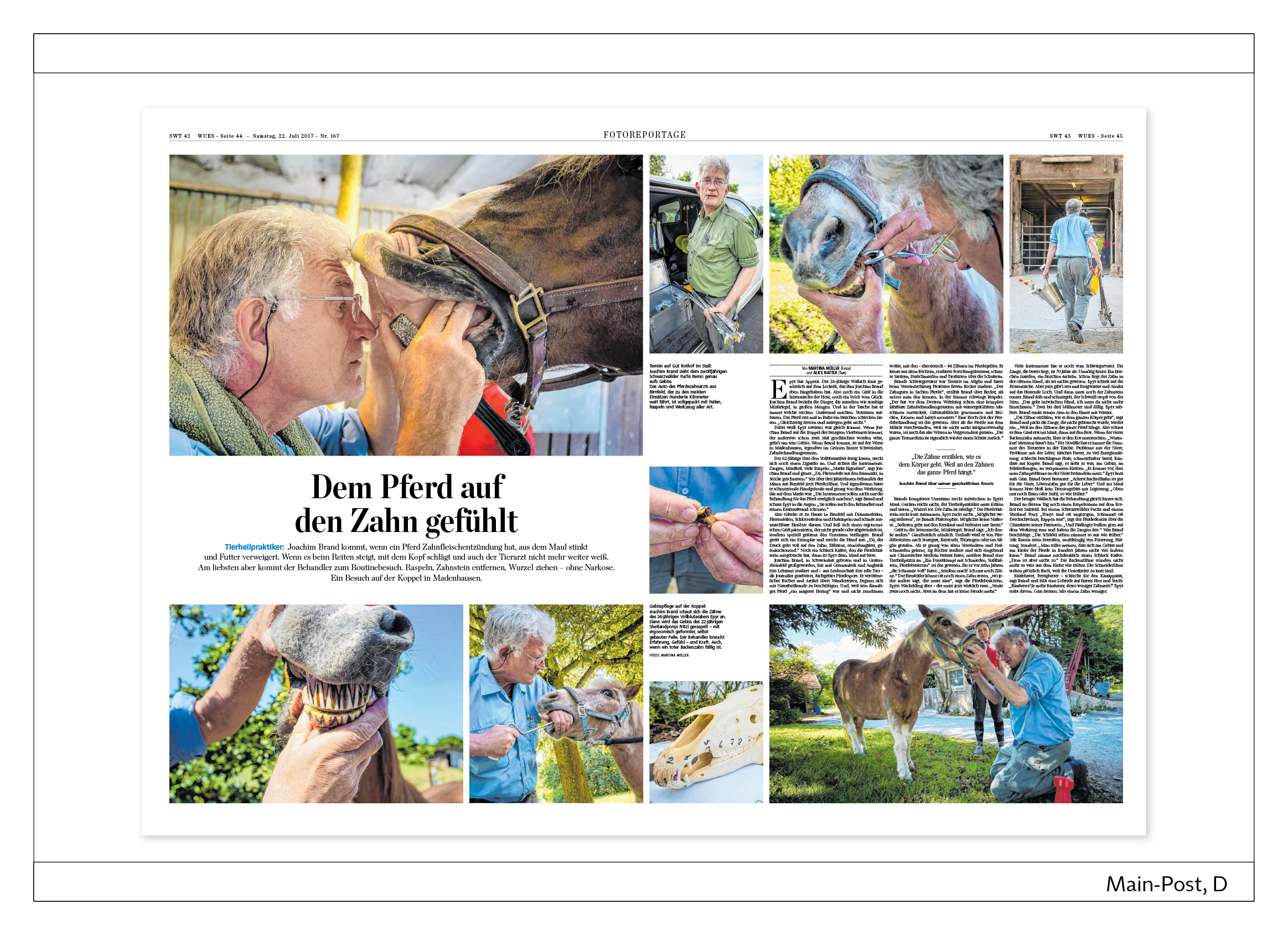
Main-Post, D. Auf der Doppelseite wird ein Tierheilpraktiker und seine Arbeit vorgestellt. Die Überschrift lautet „Dem Pferd auf den Zahn gefühlt.“ Die Bilder sind zu Blöcken arrangiert, wobei durch die Bildgrößen eine klare Hierarchie hergestellt wird.
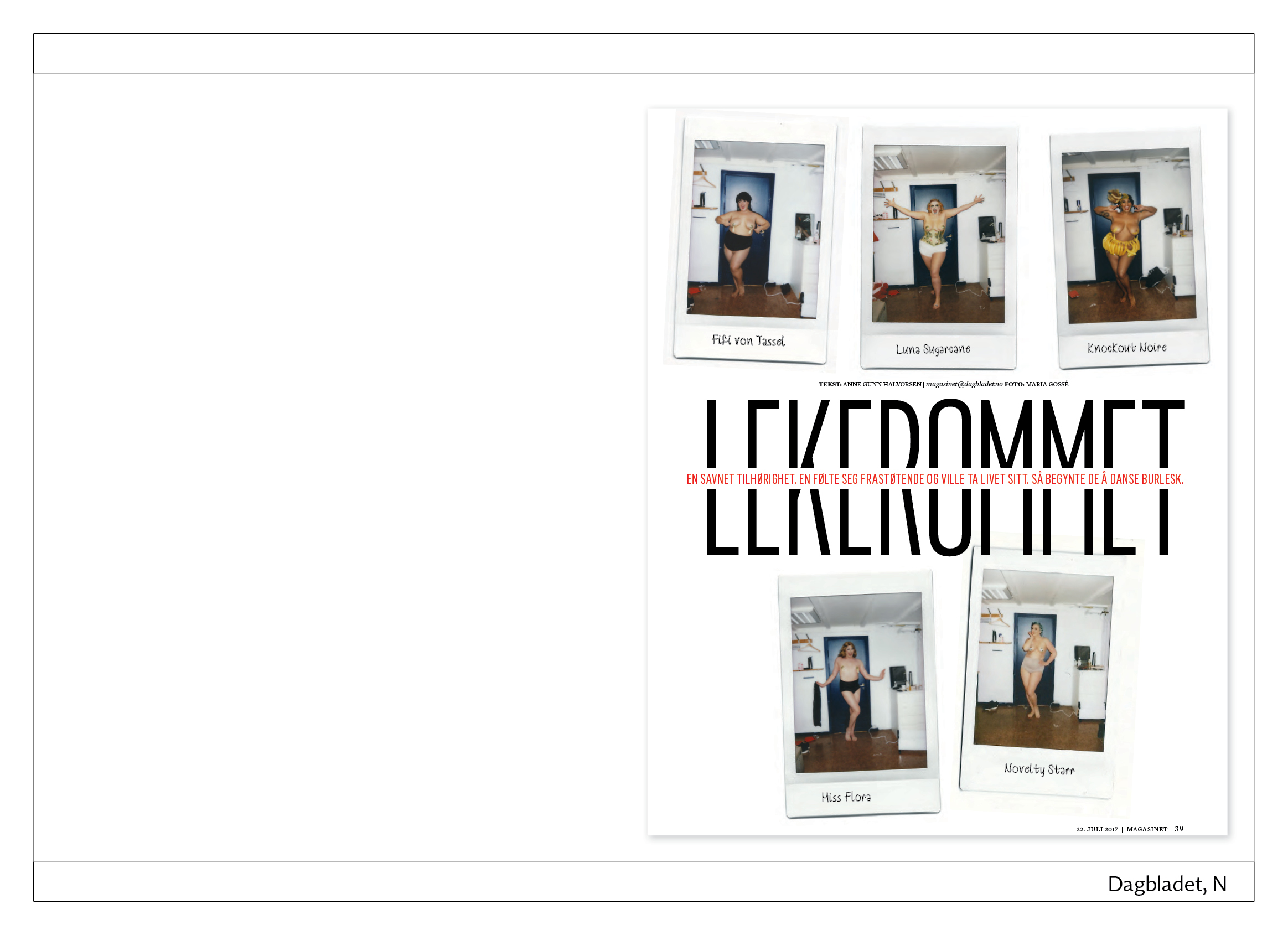
Dagbladet, N. Die Fotografin Maria Gossé folgt der norwegischen Bourlesque-Szene seit 2016. Die Fotos zeigen die Künstlerinnen und Künstler nicht auf der Bühne, sondern in ihrer privaten Umgebung. Die Foto-Reportage hat insgesamt neun Seiten Umfang: die Startseite und vier Doppelseiten.

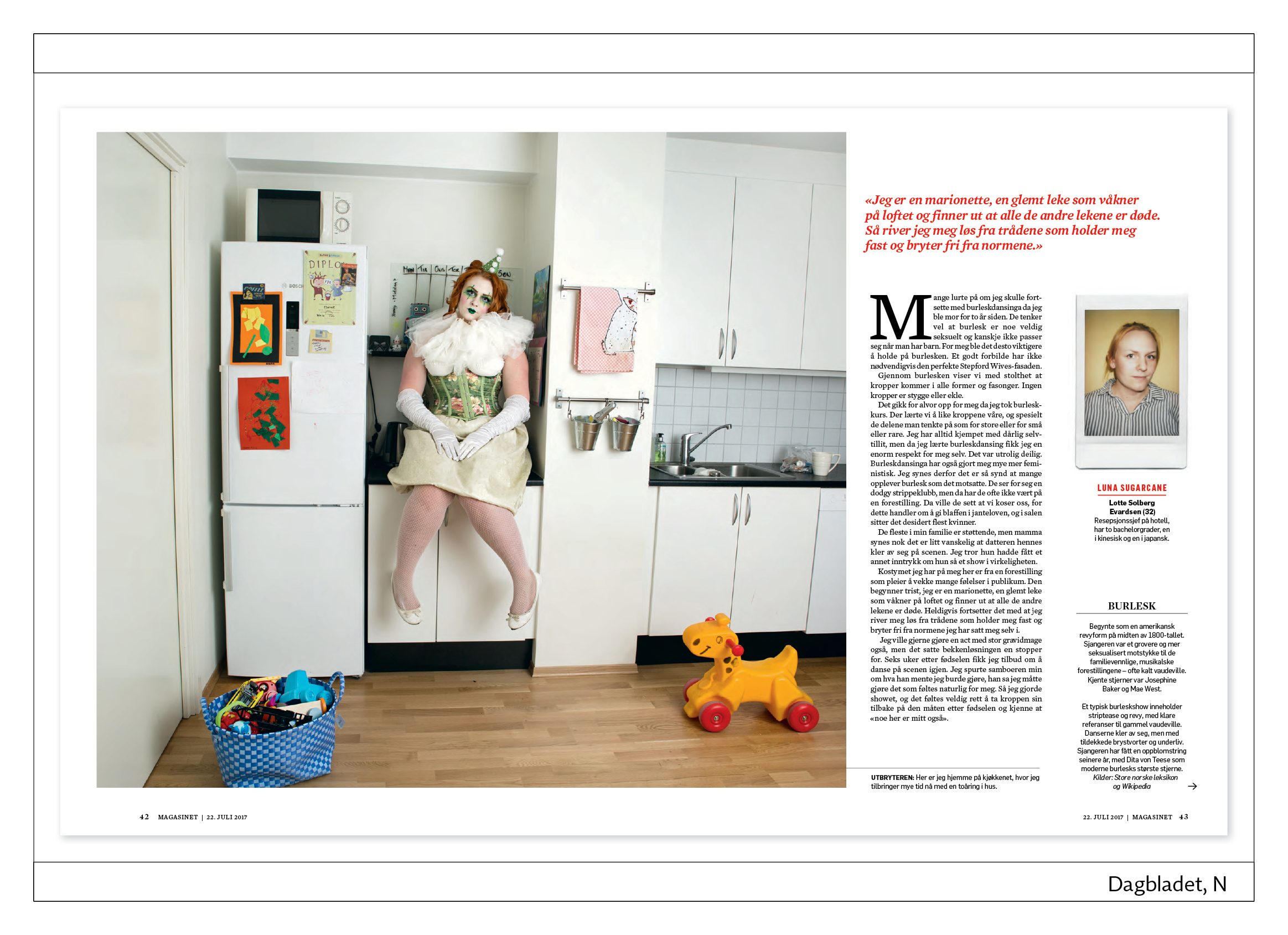
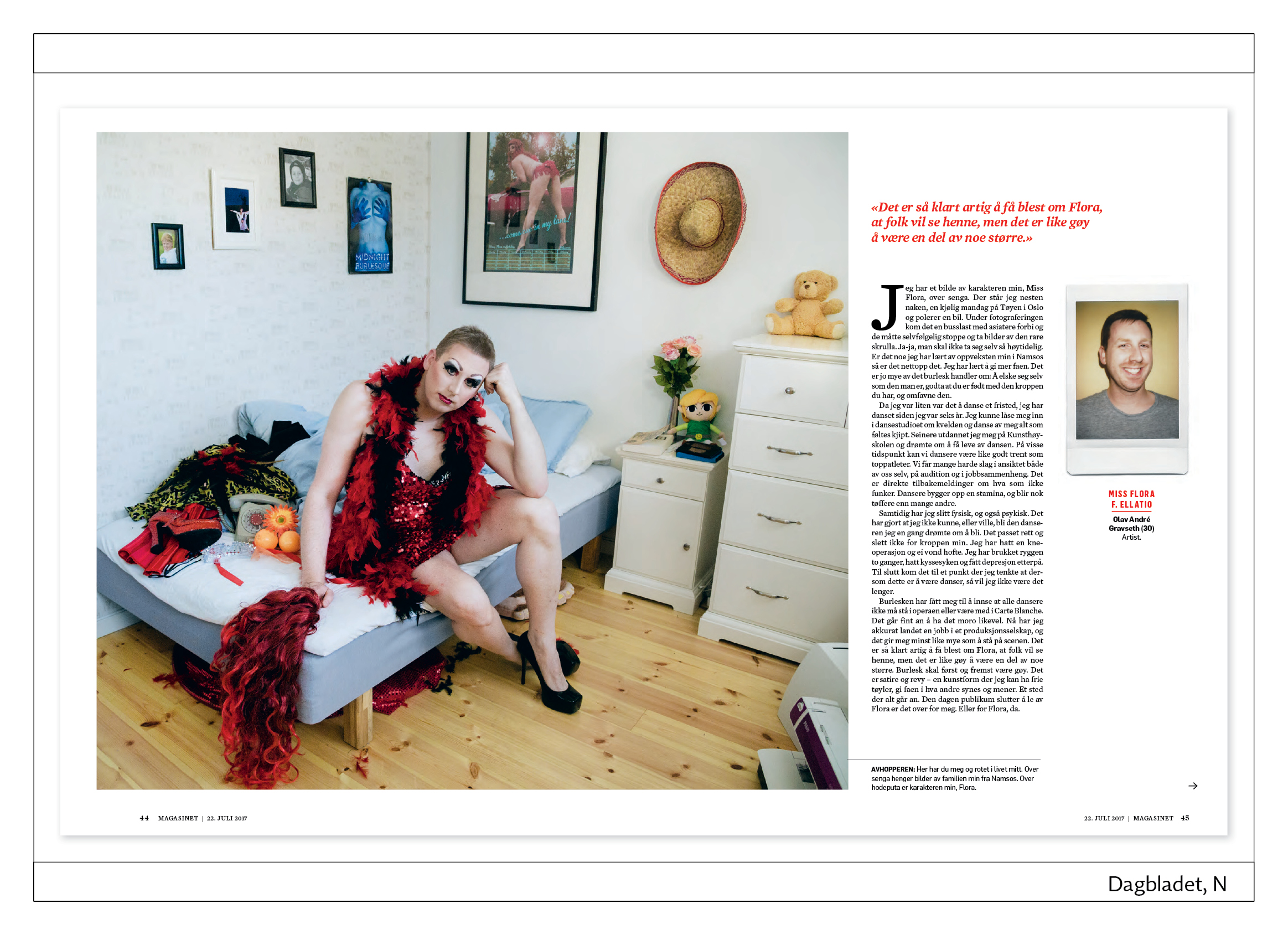
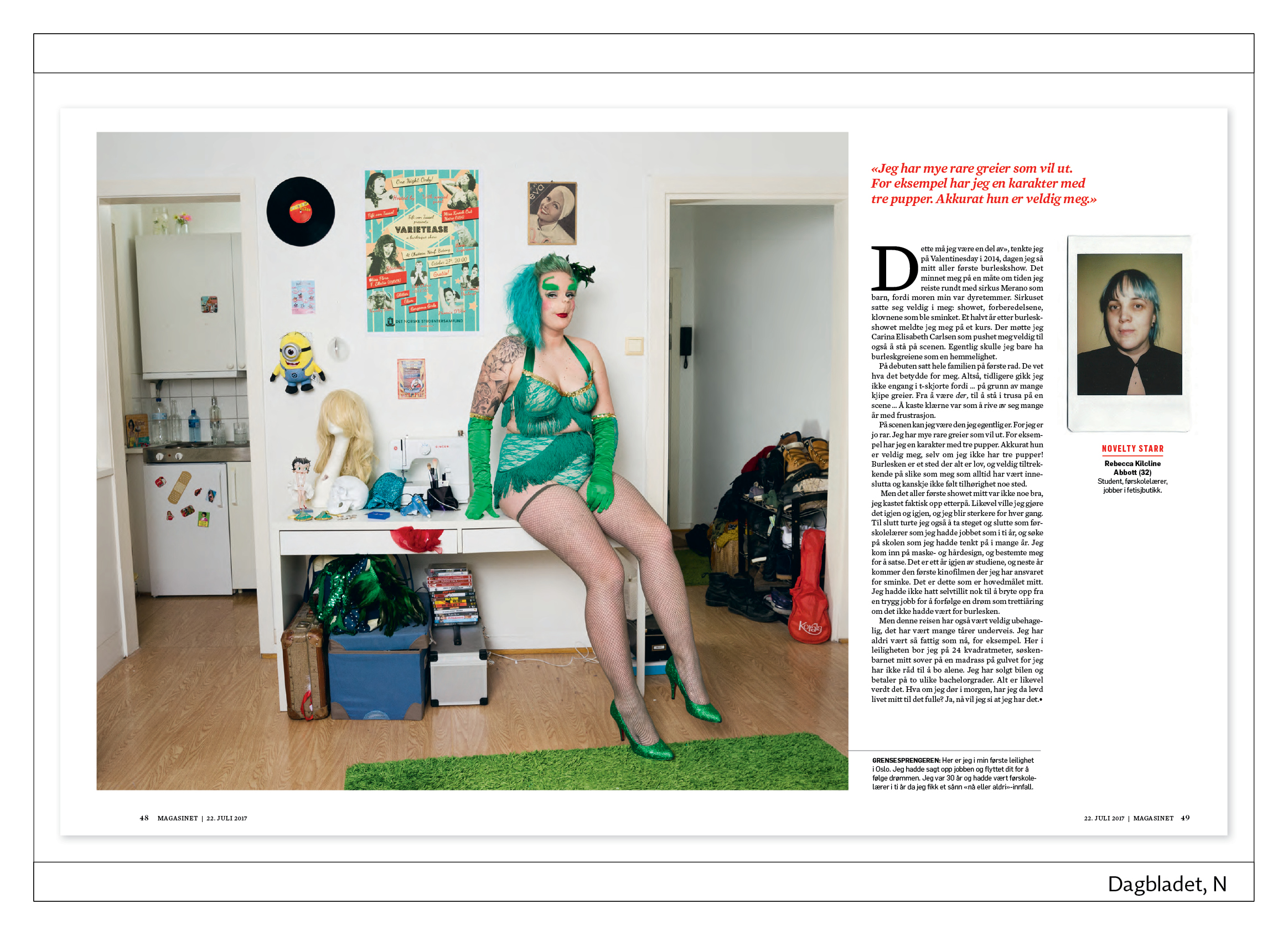
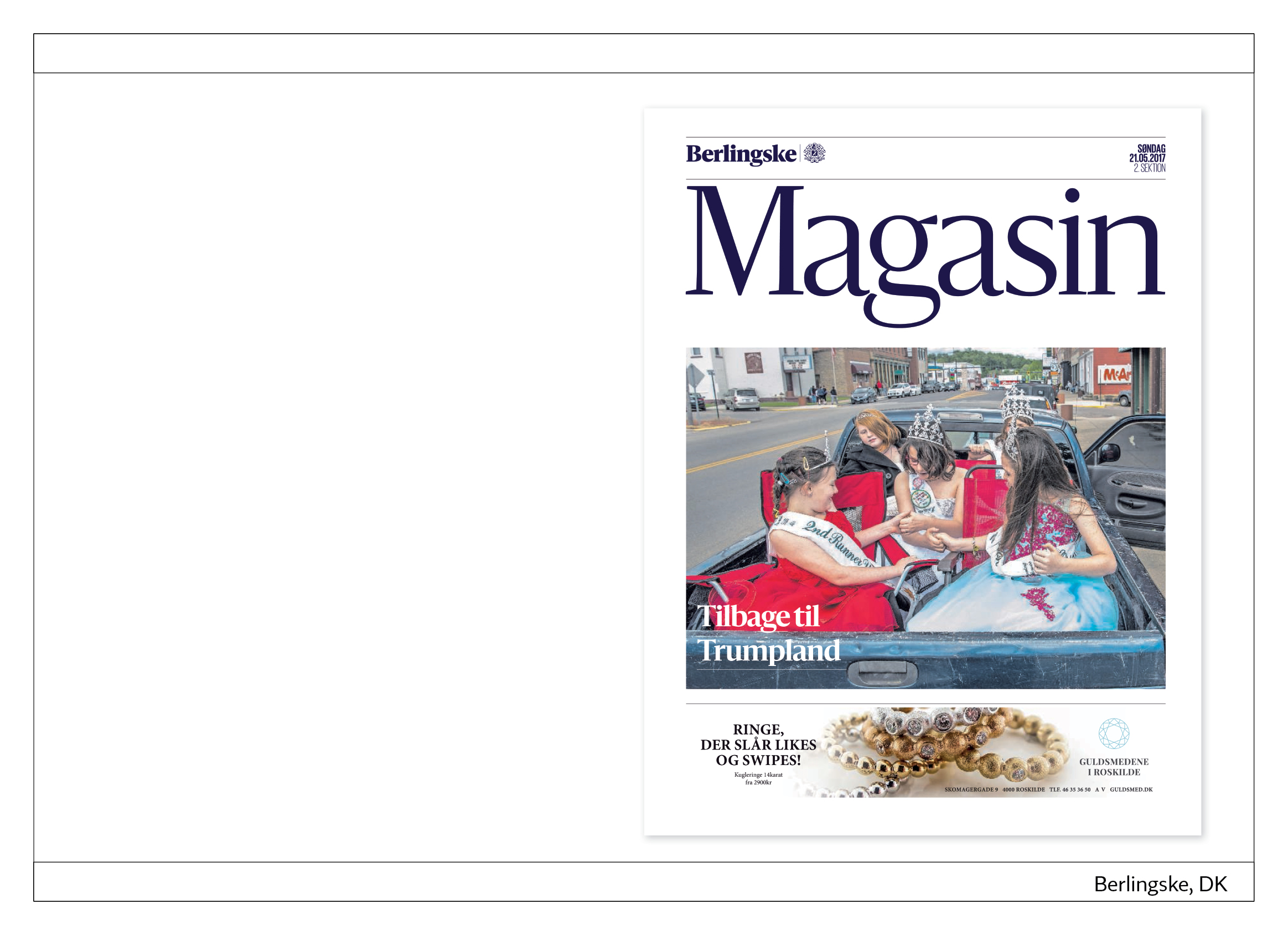
Berlingske, DK. „Hier teilen sie noch Donald Trumps Traum“ lautet die Headline. Im Vorspann heißt es: „Während die liberale Elite Trump für einen gefährlichen Clown hält, sehen Schönheitsköniginnen, Truthahnjäger und arme Leute im Rust Belt den Präsidenten als nationalen Retter.“ Rust Belt bedeutet Rost-Gürtel und bezeichnet die älteste und größte Industrieregion der USA. Die Story wird über vier Doppelseiten geführt.
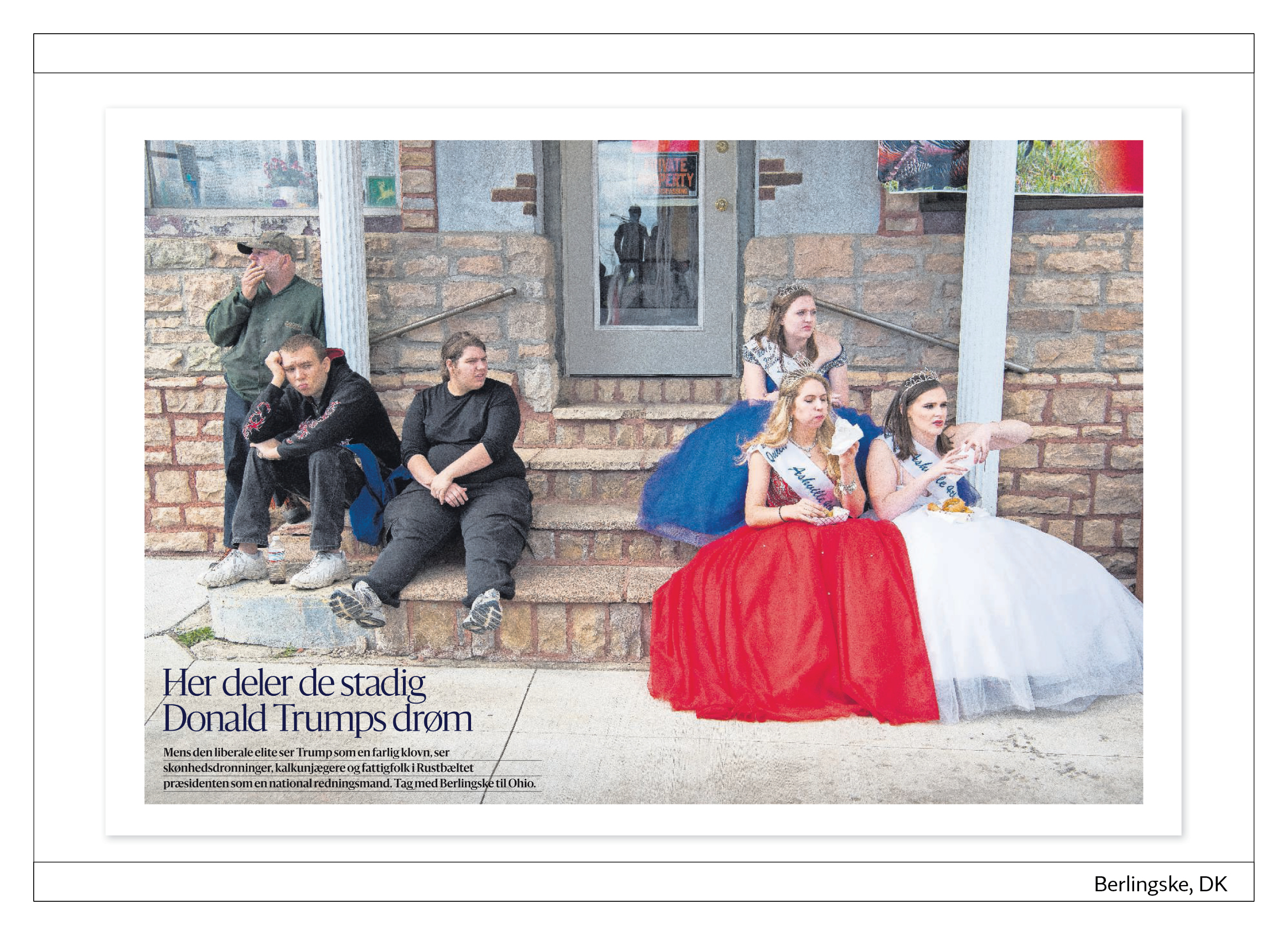
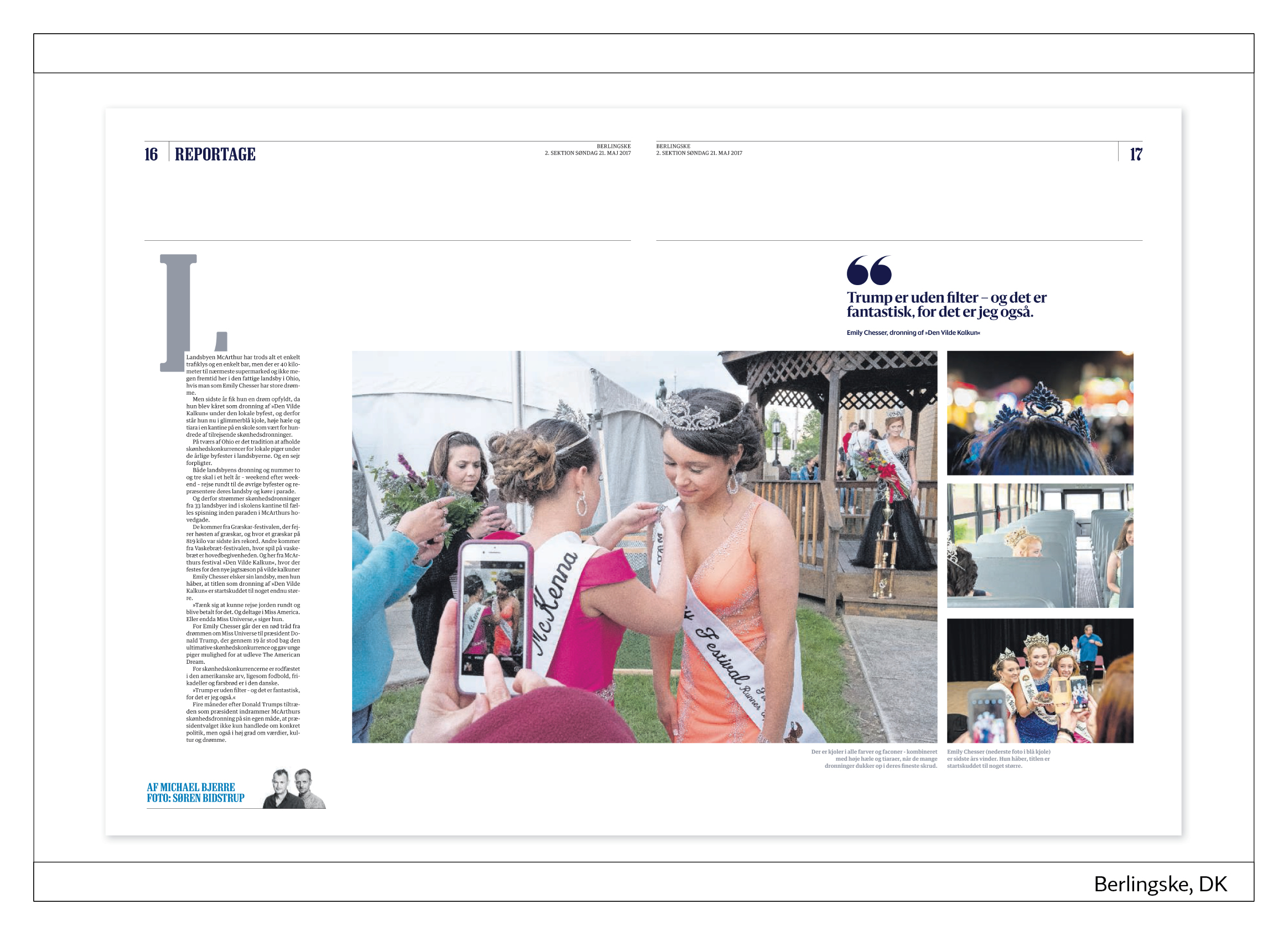
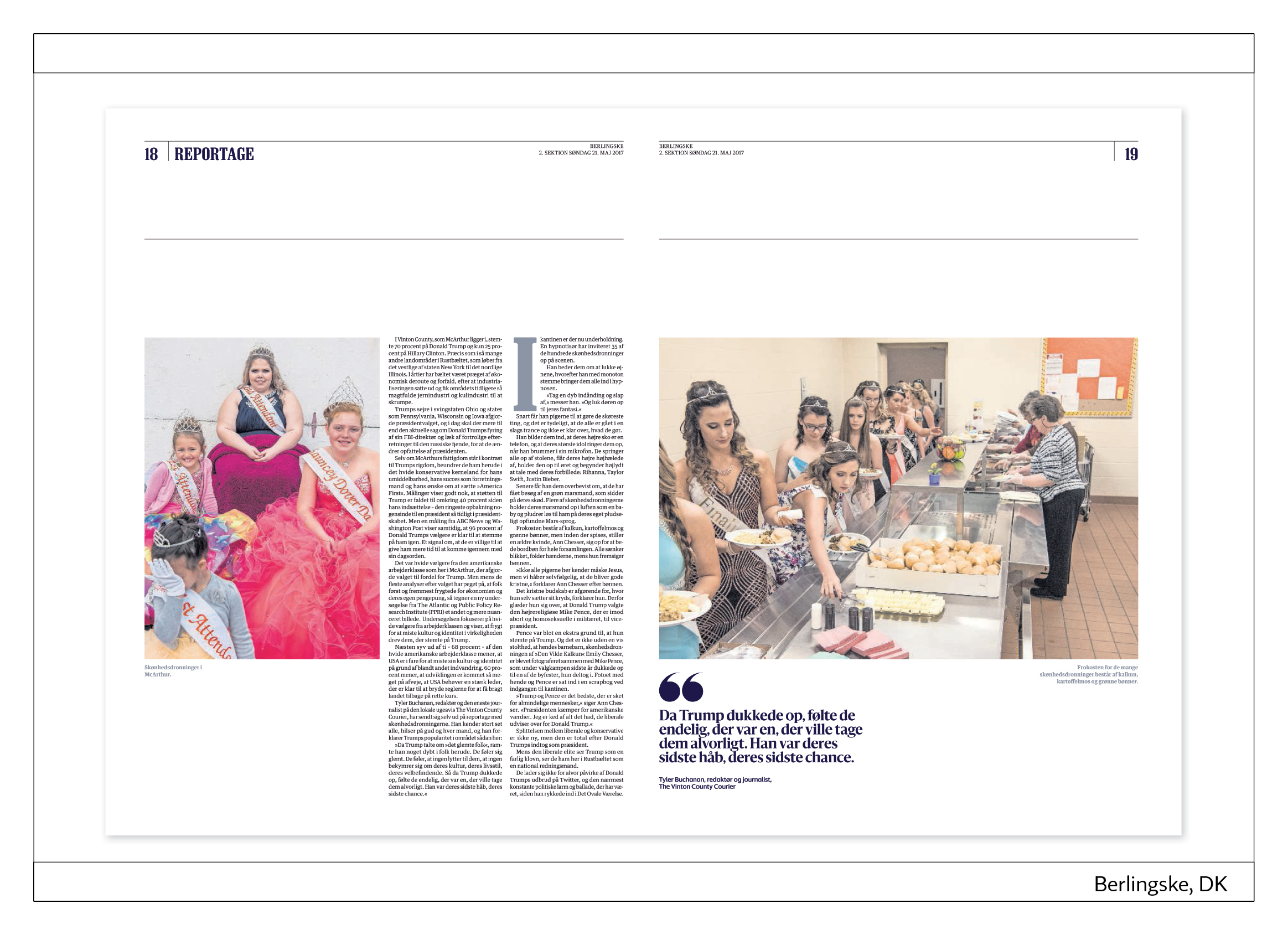
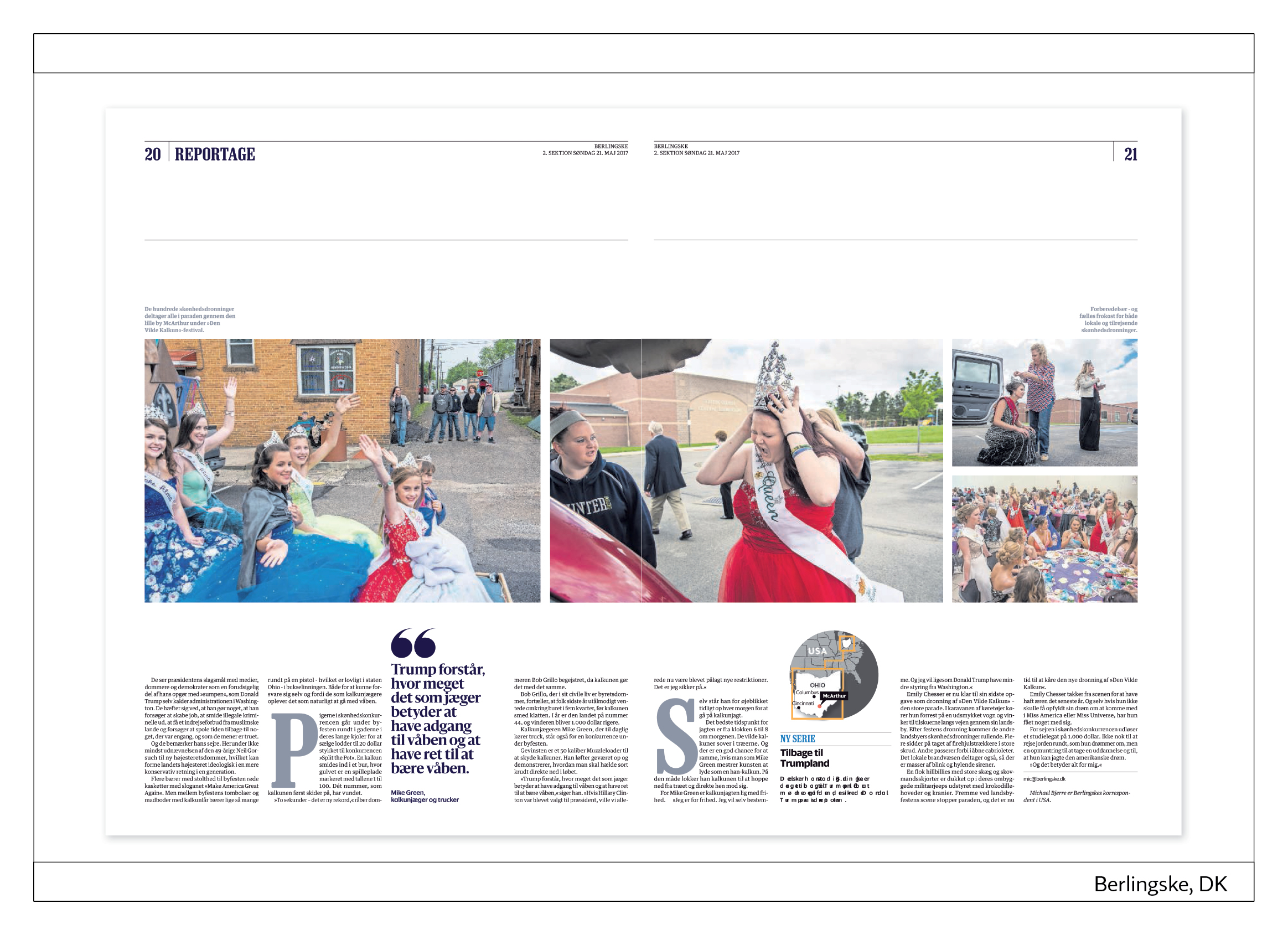
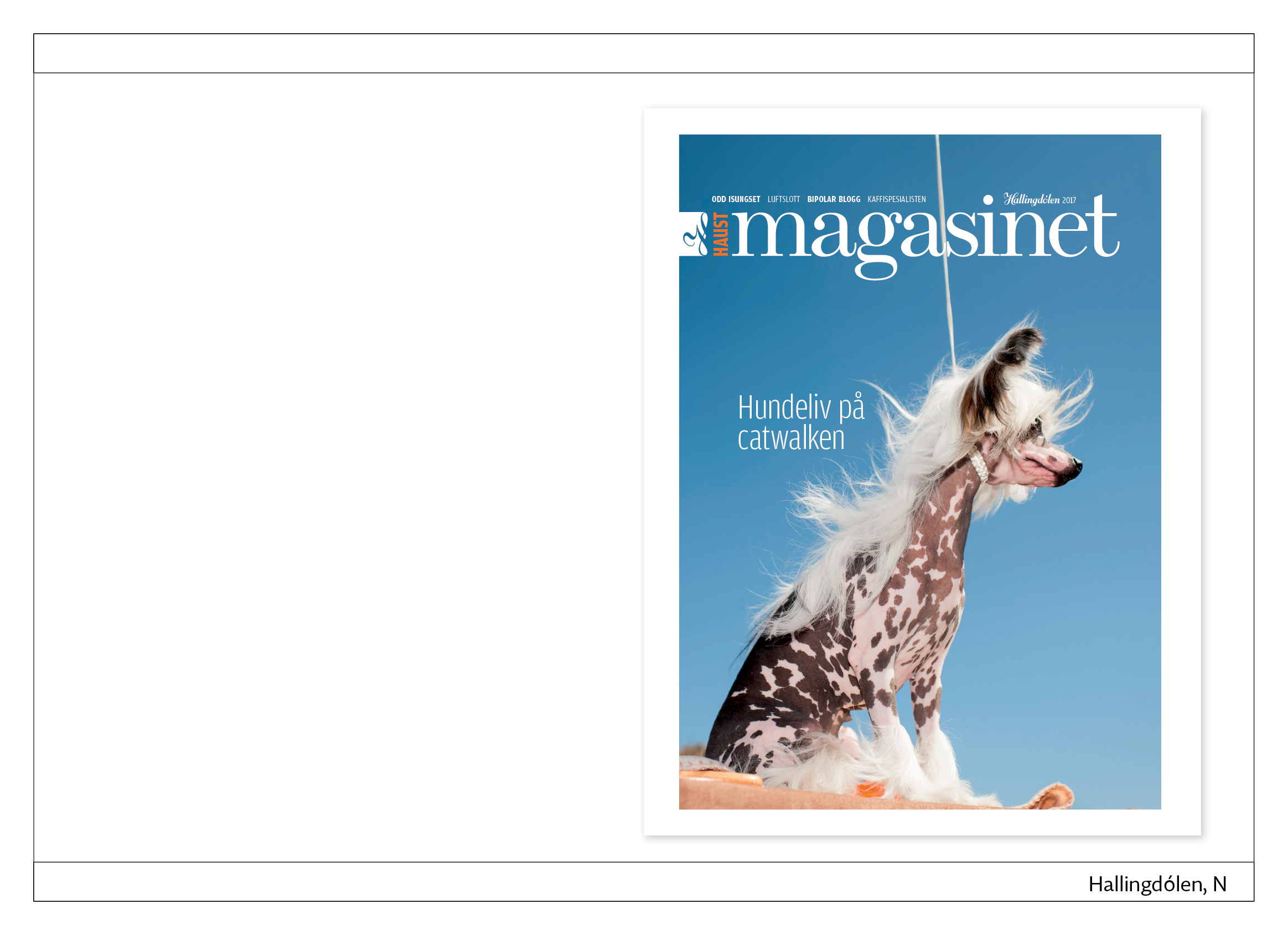
Hallingdølen, N. „Hundeleben auf dem Catwalk“ titelt die Zeitung auf dem Cover der Wochenend-Beilage. Die Foto-Reportage über eine Hunde-Schau wird im Innern über vier Doppelseiten geführt. Durch die Detail-Aufnahmen wird die Atmosphäre der Veranstaltung sehr gut eingefangen. Hallingdølen war im Jahr 2013 “European Newspaper of the Year”. Die Zeitung hat eine Auflage von 8.374 Exemplaren (2017) und erscheint drei Mal wöchentlich.

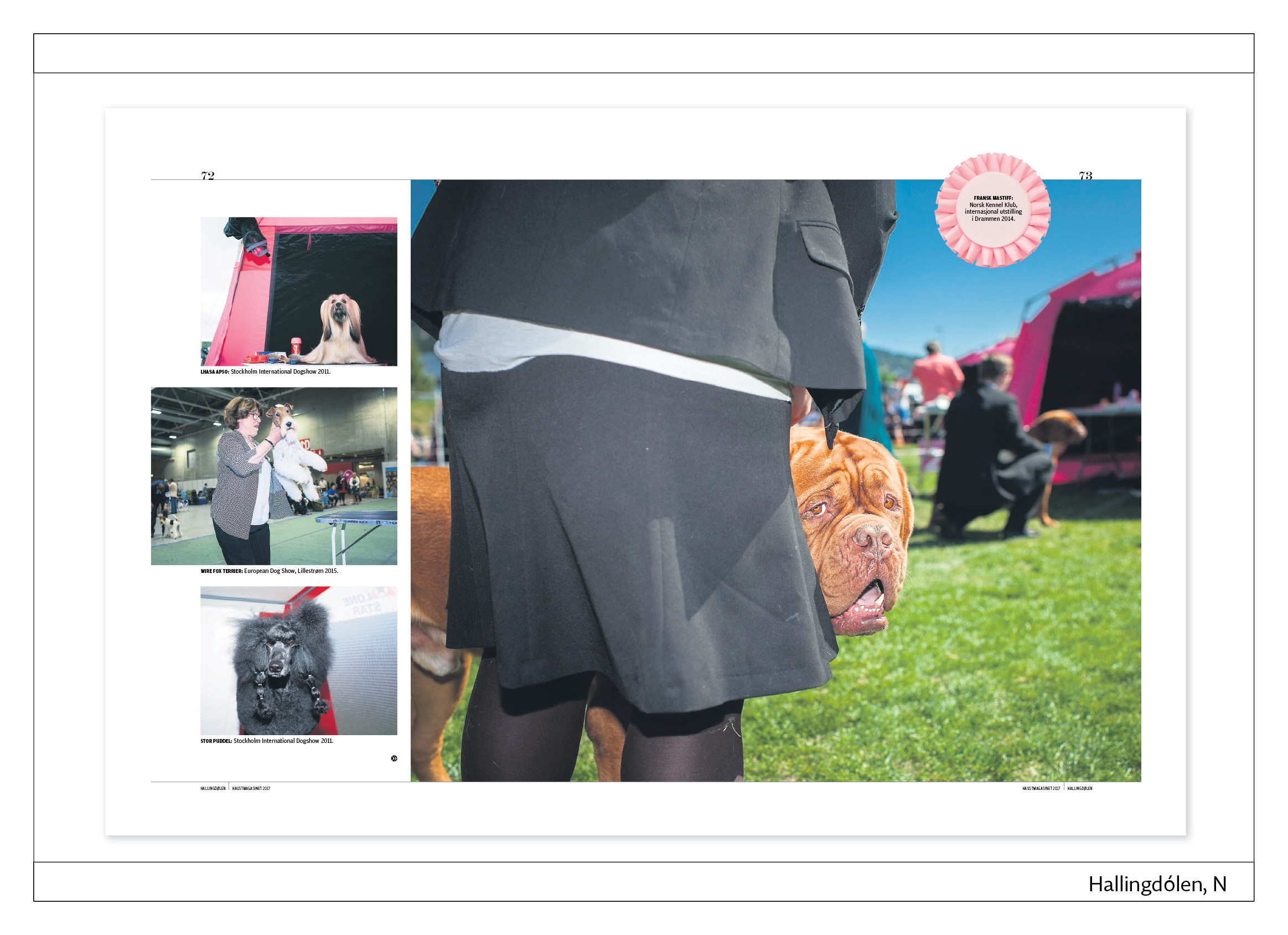
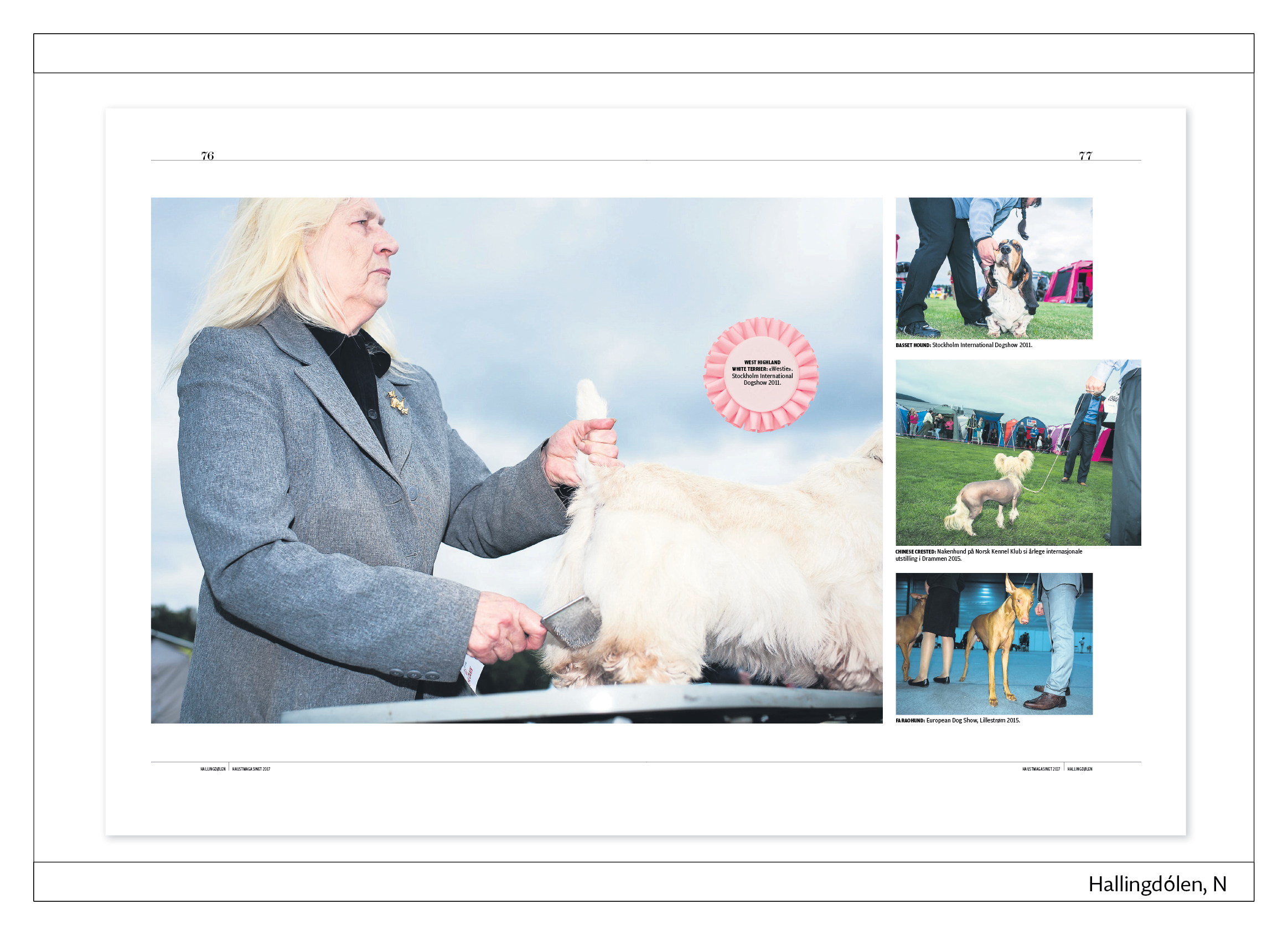
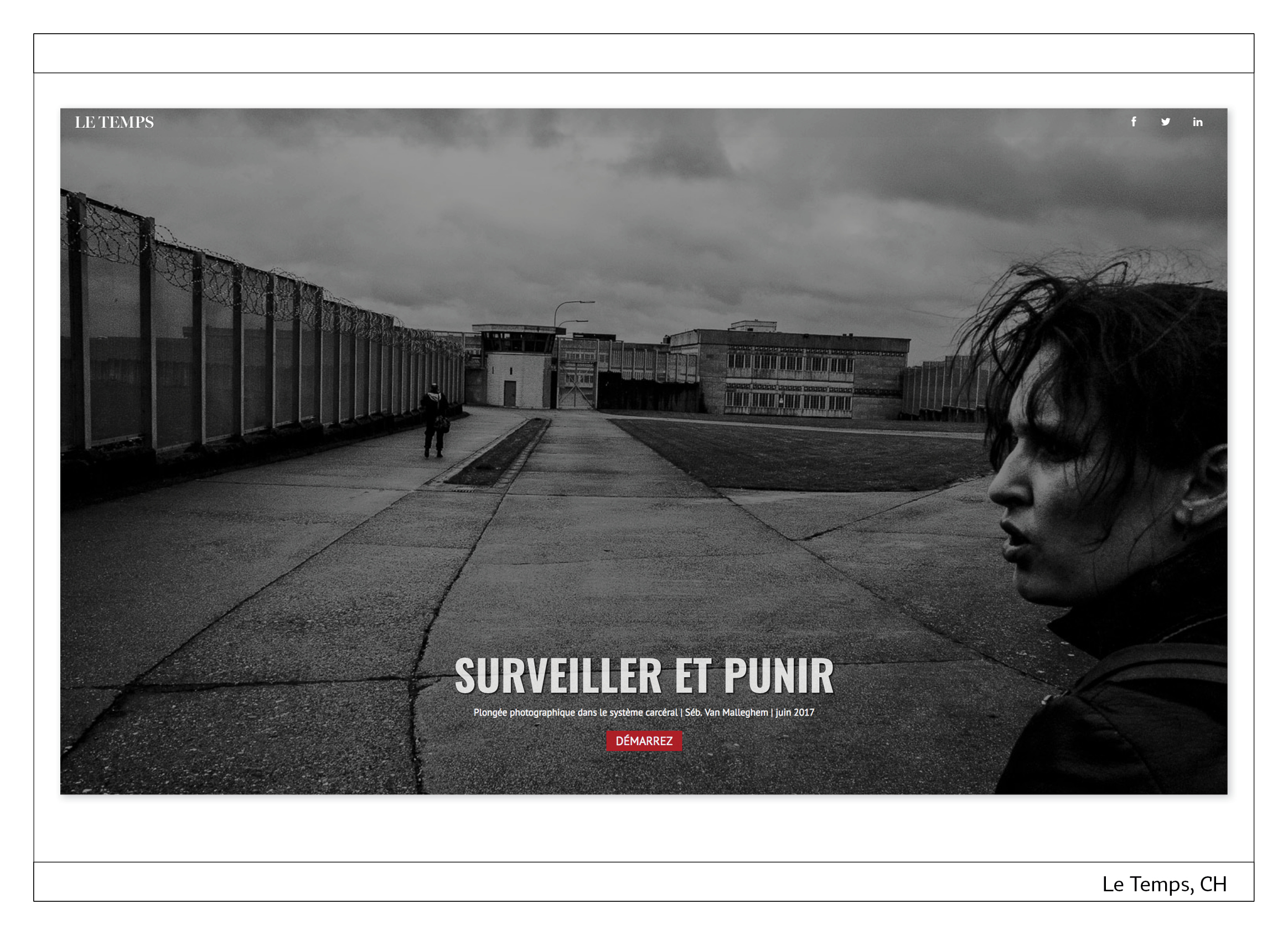
Le Temps, CH. „Surveiller et punir“ – Überwachen und bestrafen – lautet der Titel dieses Projekts. Zwischen 2011 und 2014 hat sich Fotograf Sébastien Van Malleghem in das tägliche Leben von einem Dutzend Gefängnissen in Belgien vertieft, um über die Fehler und den Bankrott des Strafvollzugs in Belgien zu berichten. Die Schwarzweiß-Fotos erzeugen eine düstere Atmosphäre der Hoffnungslosigkeit. Bildtexte, Tondokumente und Seiten mit Zitaten von Gefangenen ergänzen die Fotos. Link zur Story: tinyurl.com/y8ol3sc7
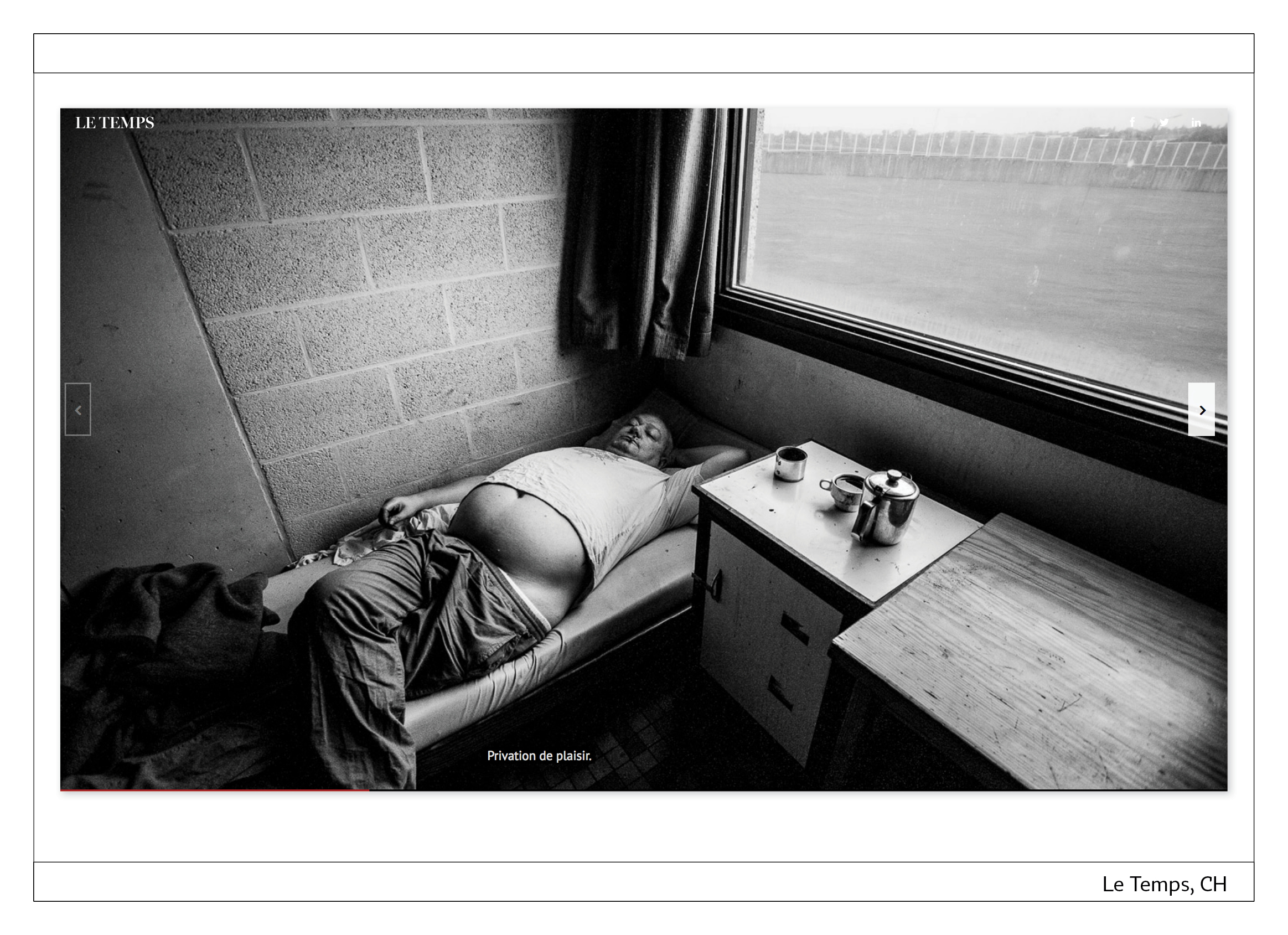
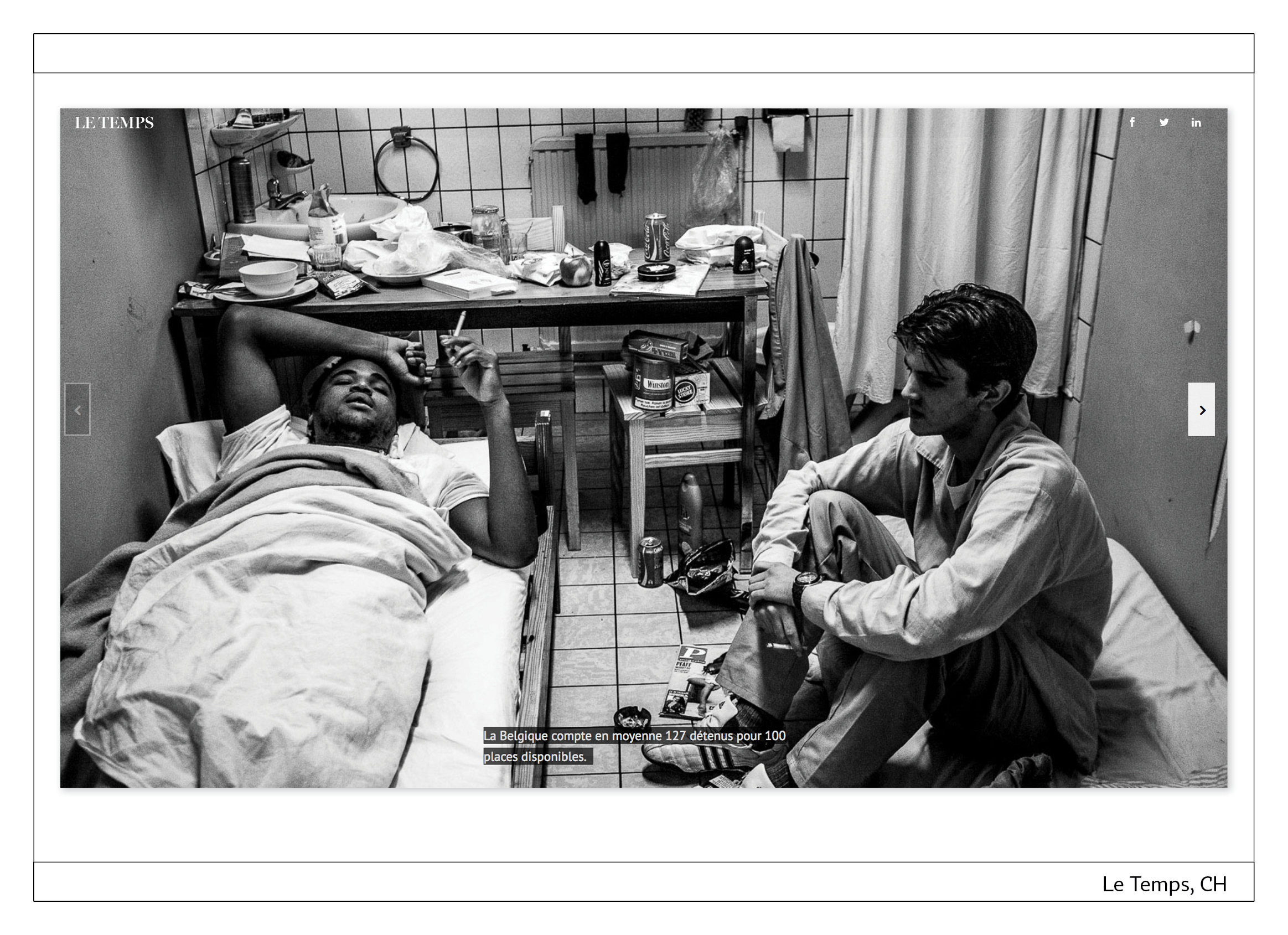
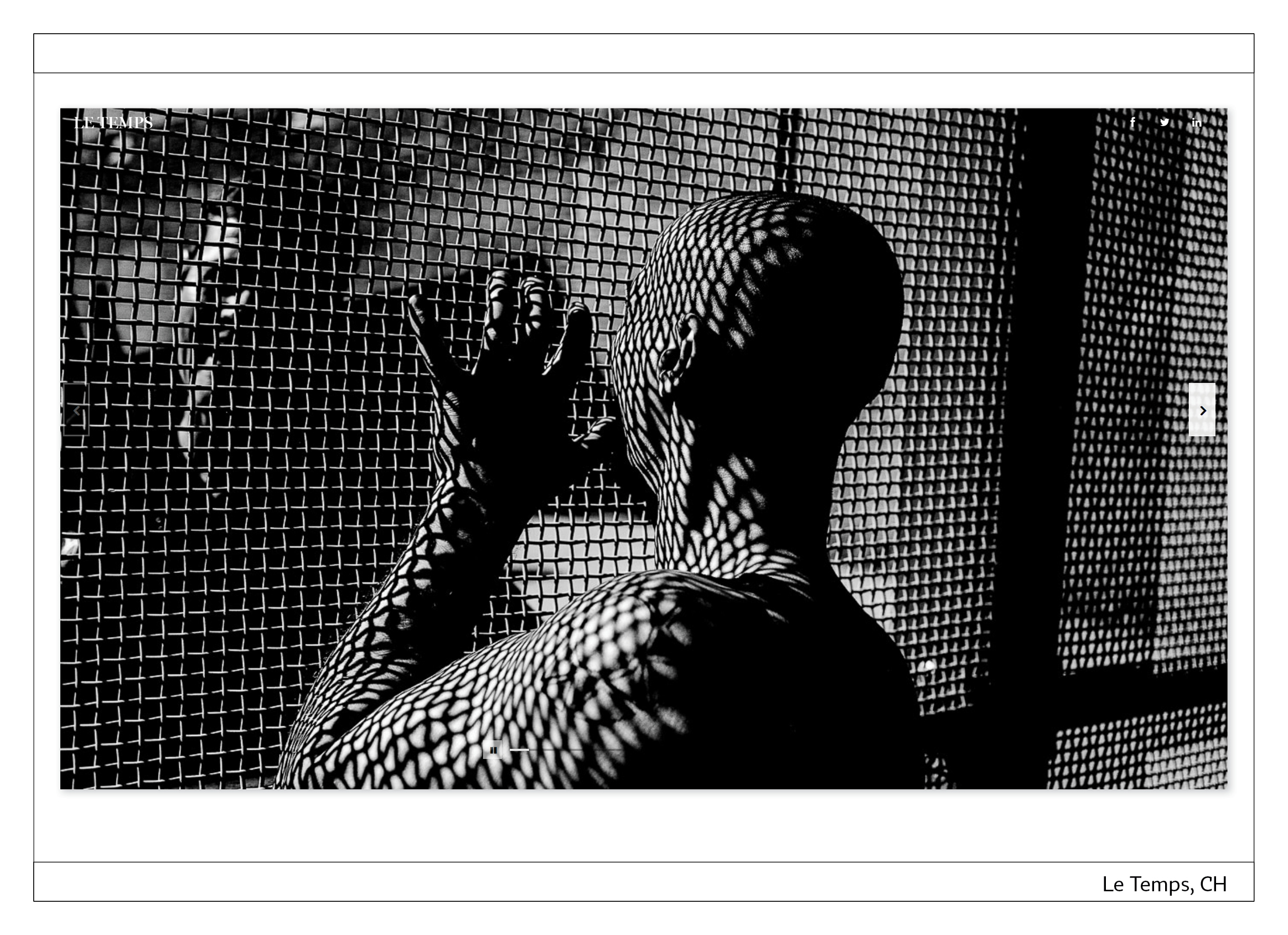
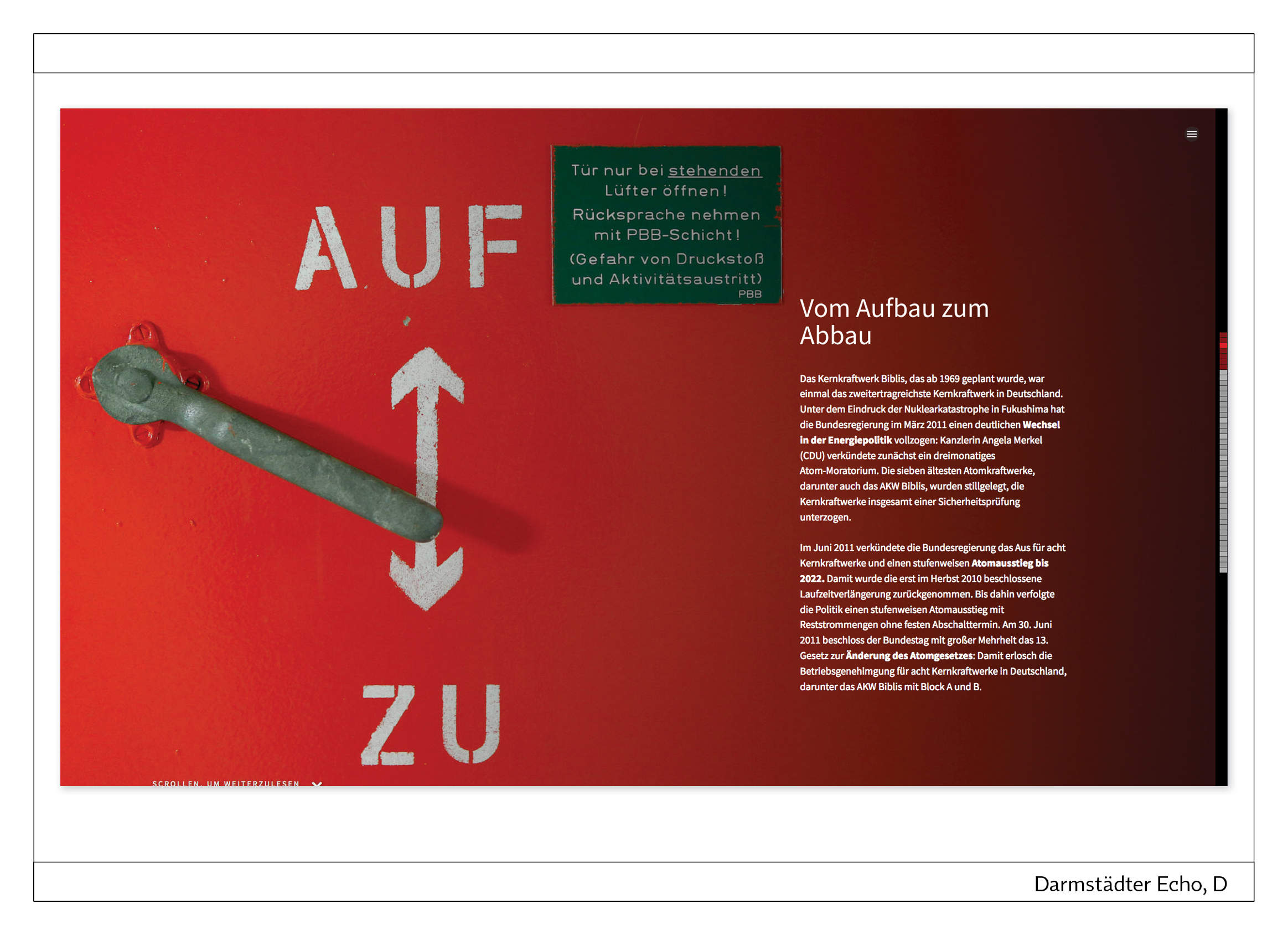
Darmstädter Echo, D. „Biblis. Und jetzt?“: Die Redaktion schreibt zu diesem Projekt: „In Südhessen geschieht etwas, das sich nur sehr selten ereignet und auch in Zukunft nur sehr selten ereignen wird: In Biblis wird ein Atomkraftwerk ‚zurückgebaut’. Wie sieht es überhaupt in so einem Kraftwerk aus? Wie geht so ein Rückbau von statten? Wie sehen die Bibliser diese Entwicklung? Welche Positionen gibt es? All diese Themen werden in der multimedialen Geschichte aufgegriffen.“ Um auf diese Story aufmerksam zu machen, gab es eine achtseitige Beilage in der gedruckten Zeitung. Link zur Story: tinyurl.com/ycoubgfr
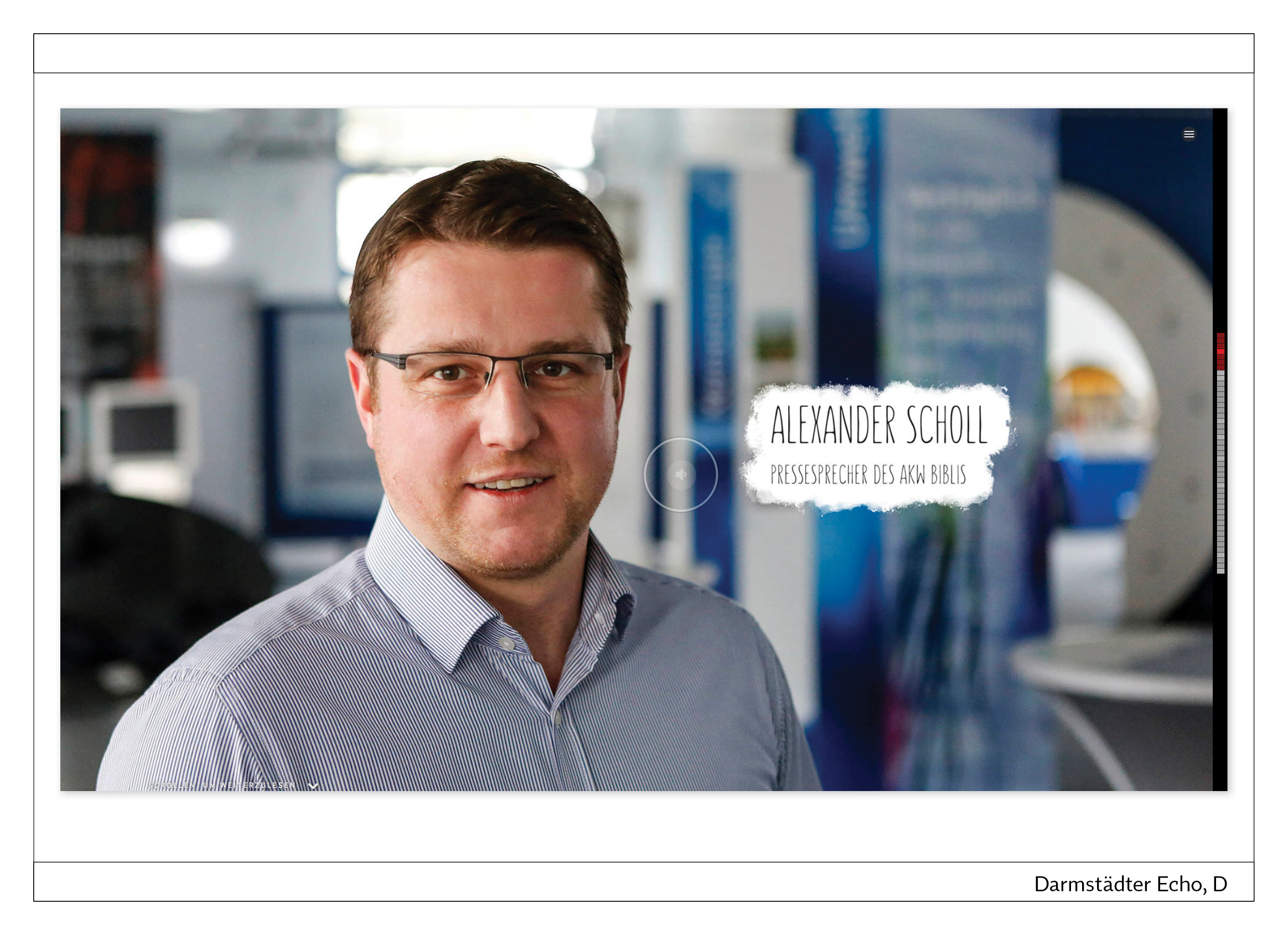

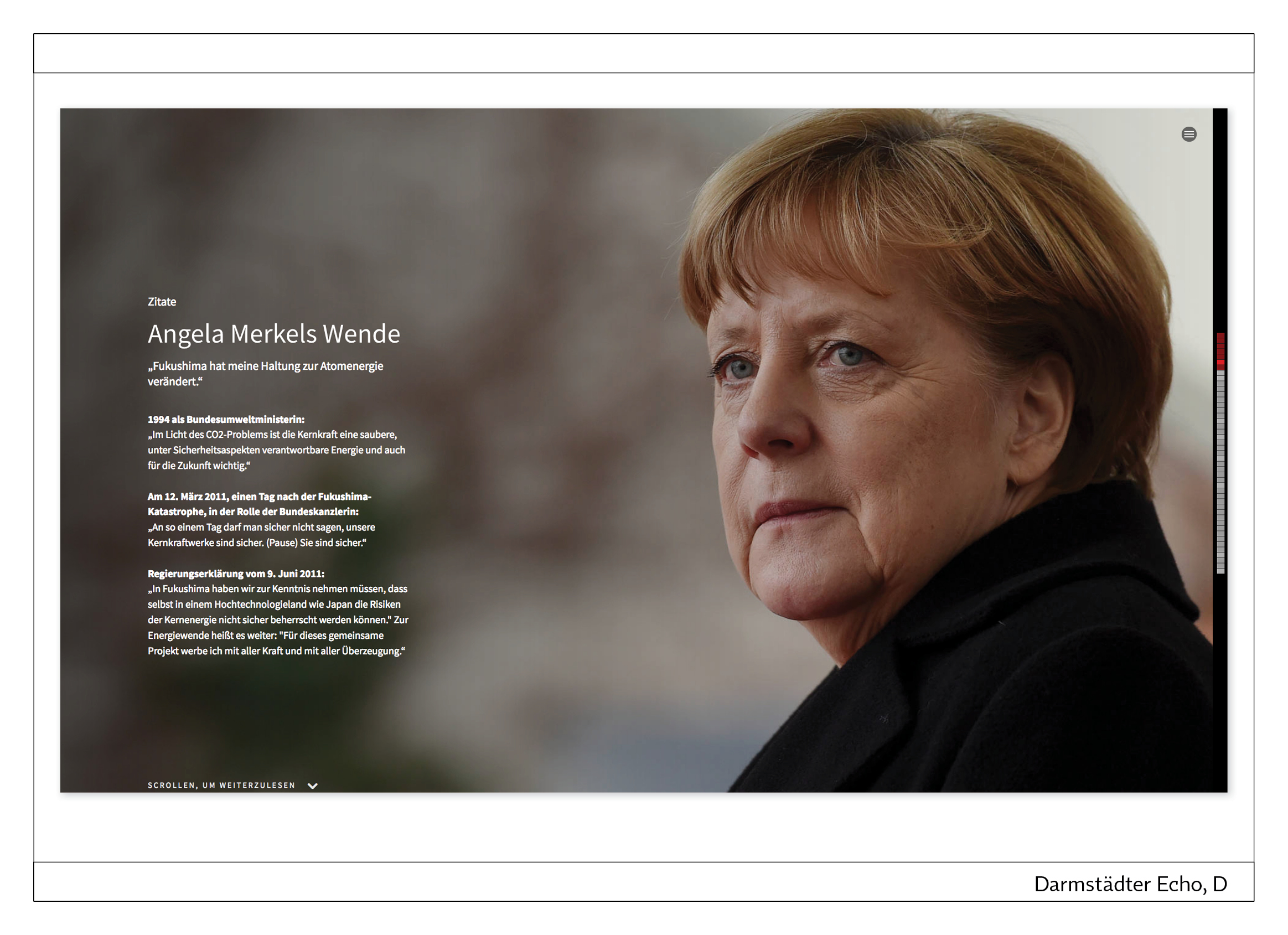
Kontakt:
Norbert Küpper, Büro für Zeitungsdesign, Gutenbergstr. 4, 40670 Meerbusch, Deutschland, Telefon +49 2159 911615, Email: nkuepper@newspaperaward.org Website: www.newspaperaward.org
Norbert Küpper ist Veranstalter des European Newspaper Award.
Newspapers continue to evolve, both in print and online. The European Newspaper Award shows the latest trends every year. If you look at the examples on the website www.newspaperaward.org or work through the yearbook (order HERE), you will notice that the slogan “Yes, we can!” By Barack Obama fits well with the positive, optimistic attitude that the makers of excellent work mediate.
This year, the best newspapers in Europe come from Luxembourg (Tageblatt), the Netherlands (De Limburger), Norway (Morgenbladet) and Germany (Handelsblatt). All in all, 185 newspapers from 27 countries took part in the 19th European Newspaper Award.
Large number of submissions in print and online. Once again newspapers from most European countries competed for the 19th European Newspaper Award. There is no drop in the number of pieces of work submitted, and the high quality impressed the jury.
Main trend: gradual further-development in the print sector. Newspapers have many subscribers who are not necessarily open to every new feature. That is why there tends here to be a gradual further-develop-ment rather than abrupt changes. The general trend is away from full, self-contained text and towards alternative story forms and visual storytelling. Major topics in many newspapers are spread across double-pages and presented with maps, infographics and charts.
120 online projects by 30 newspapers. The quality of online submissions has risen. The jury were presented with about 120 projects by 30 newspapers from all over Europe. One Judges‘ Special Recognition went to the Tages-Anzeiger, Zürich, for this newspaper’s numerous outstanding online projects.
Online trend: film projects and “Snow Fall” stories. Six film projects and 14 multimedia stories received awards. These related to, for example, portraits of people in the region (Main Post, Würzburg) or elucidating the voting system in the USA with the aid of animated infographics. Especially impressive was a reportage by Politiken, Denmark, on rescuing refugees from the Mediterranean.
Social media. Newspapers are naturally also active in the social media sector. For that reason there is a separate category for these. One distinction went, among others, to the Axel Springer Academy for the snapchat project “Sachor jetzt” (Hebrew for “Remember now.”). This was developed by 16 volunteers of the Academy. Documentation of this project can be found at: www.sachor.jetzt
Magazine look. A trend that started particularly in Northern Europe is that of designing newspapers to look like magazines. The Tageblatt, Luxembourg, has developed more in this direction in recent years. Cover stories that are carried on inside the paper and alternative story forms form part of the daily repertoire of this newspaper, which this year won one of the four main prizes.
Cover and cover story. The trend towards cover and cover story has been intensifying amongst Europe’s newspapers. Local and regional newspapers in Scandinavia and in Belgium and The Netherlands as well give prominence to a topic
1 The Saturday paper is transformed into a a weekly paper.
This is what‚ Allgemeine Zeitung Mainz‘ is doing together with their joint publishers. The volume has been extended and new topics have been inserted, which make for a relaxed leisure time reading. Each front page of the local sections on that day is almost devoted to a single issue.
2 Poster-like covers.
More and more newspapers have decided to use a big lead-in topic. In this respect, ‘Tageblatt‘ from Luxembourg, published in the Berlin format, is certainly prominent in the German language area. Many other newspapers like ‘Kleine Zeitung‘ from Graz (A), ‘Polska‘ or ‘Delovoy‘ from St. Petersburg use a tabloid format which makes it easier for their covers to resemble posters.
3 Professional ‘snow fall‘ projects.
In recent years, newspapers have experimented with this and other online-formats. In this year‘s competition it has become evident that this new journalistic tool is now common knowledge and professionally used.
4 Online trend towards text-driven news apps.
Already at the last competition, news apps that could be navi-gated intuitively had been awarded. Examples are ”Der Tag“ – The Day – of ‘Frankfurter Allgemeine Zeitung‘ (FAZ) and “app12” of ‘Tages-Anzeiger‘. Mostly lengthy texts are offered on smart phones. A high user rate is indicative of their success.
5 Visual journalism remains trendy.
Alternative story forms, visual story telling, photo reportages – all those journalistic genres continue to be used for the printed media. The trend towards a stronger visual presentation of contents is still there.
6 Data journalism: only few specialists.
‘Berliner Morgen-post‘ and ‘Tages-Anzeiger‘ stand out because of their great number of projects containing data journalism. But it seems that there are only few specialists who can make large amounts of data accessible online.
7 Increase in infographics in Central Europe.
For some time the Iberian Peninsula and Greece had been the trailblazers for double-page infographics. This journalistic feature has now crossed the borders of Denmark, Great Britain, the Benelux states and German speaking countries.
European Newspaper Award:
Since its foundation in 1998, the competition has been organized by newspaper designer Norbert Küpper. The 19th contest involved 185 newspapers from 27 countries.
European Newspaper Congress:
In the first four years, the award ceremony took place in the Coronation Hall of the Aachen City Hall. In 1993 Norbert Küpper founded the European Newspaper Congress, where innovative print and online projects from across Europe are presented. The European Newspaper Congress has been held in Vienna since 1994. It is carried out by the Verlag Oberauer from Salzburg in cooperation with Norbert Küpper.
Alongside the Awards of Excellence there are four main prizes. The European Newspaper Award has always been divided up into local newspaper, regional newspaper, nationwide and weekly newspaper categories, because these four newspaper types have different resources and target groups.
European Newspaper of the Year, Category Local Newspaper:
Tageblatt, Luxembourg
European Newspaper of the Year, Category Regional Newspaper:
De Limburger, the Netherlands
European Newspaper of the Year, Category Nationwide Newspaper:
Handelsblatt, Germany
European Newspaper of the Year, Category Weekly Newspaper:
Morgenbladet, Norway
This newspaper appears in Luxembourg in Berliner format and has a circulation of about 20,000. The newspaper employs 30 journalists, six photographers and four layouters.

Jury statement
The Tageblatt has been continuously developed as regards content and design in recent years. The front page shows just by its visually well-prepared theme that the paper is produced more in the style of a weekly newspaper. Instead of briefly touching upon a number of topics it presents a few well-chosen ones in detail for the reader. Not only text but also alternative story forms and infographics are employed. There is no doubt about it, the Tageblatt is European Newspaper of the Year and will be able to display the proof of this at its masthead for a year.
This newspaper appears in the province of Limburg in tabloid format. The newspaper has a circulation of 122,614. Editorial staff include 98 journalists, 17 photographers and 12 layouters. The newspaper was given an award during the very first European Newspaper Award competition. At that time it was still appearing in full format and bore the name „Dagblad de Limburger“.
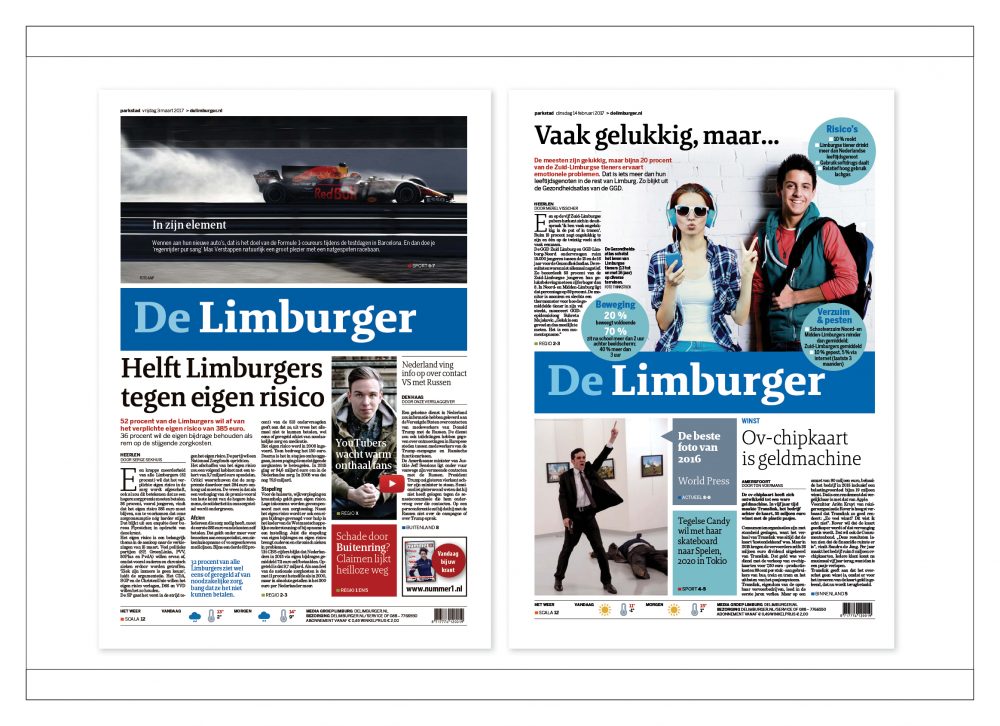
Jury statement
De Limburger has a very modern, visually emphatic front page. Two to three topics are presented here. New layout variants are always selected. In that way an impression of sameness is avoided. The newspaper has various sections, where the style of the front page is carried on. These include the local sections and Scala, Horizon and Sport. Here likewise a great deal of background is offered and fewer short reports. At the week-end there is the L Magazine – Lekker Weekend (Great Week-End). In this magazine the editors demonstrate creativity in their choice of topic and layout.
This newspaper has a circulation of 122,015. Of these 44, 537 are in e-paper form (German Audit Bureau of Circulation (IVW) 3/2017). Around 200 editors, correspondents and permanent employees work for the Handelsblatt, six of them layouters, five photo editors and seven infographic artists. The newspaper does not have its own photographers.
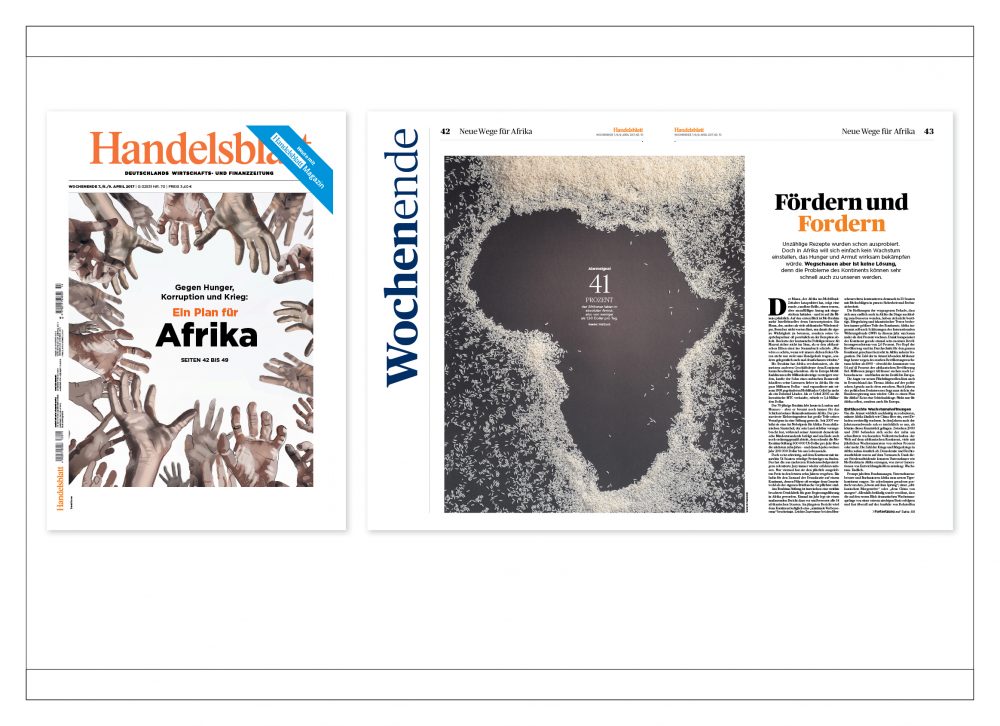
Jury-Statement
Because of its handy tabloid format the Handelsblatt is pleasantly different from other newspapers. Daily two-page infographics were recently introduced, and the cover stories at the week-end are virtually without equal in Europe for their level of detail and magazine-style layout. The process of transformation in the direction of electronic media is well under way here, because one-third of the circulation is in e-paper form. This means that customers are very open to innovation. A highlight of online activity is the publisher’s Morning Newsletter, which is often quoted in other media.
Morgenbladet is published in Oslo with a circulation of 29.000 copies and online on morgenbladet.no. The newspaper has an in-house staff of 29 editors, journalists, photographers, Art Director and marketing as well as a large portfolio of freelancers.
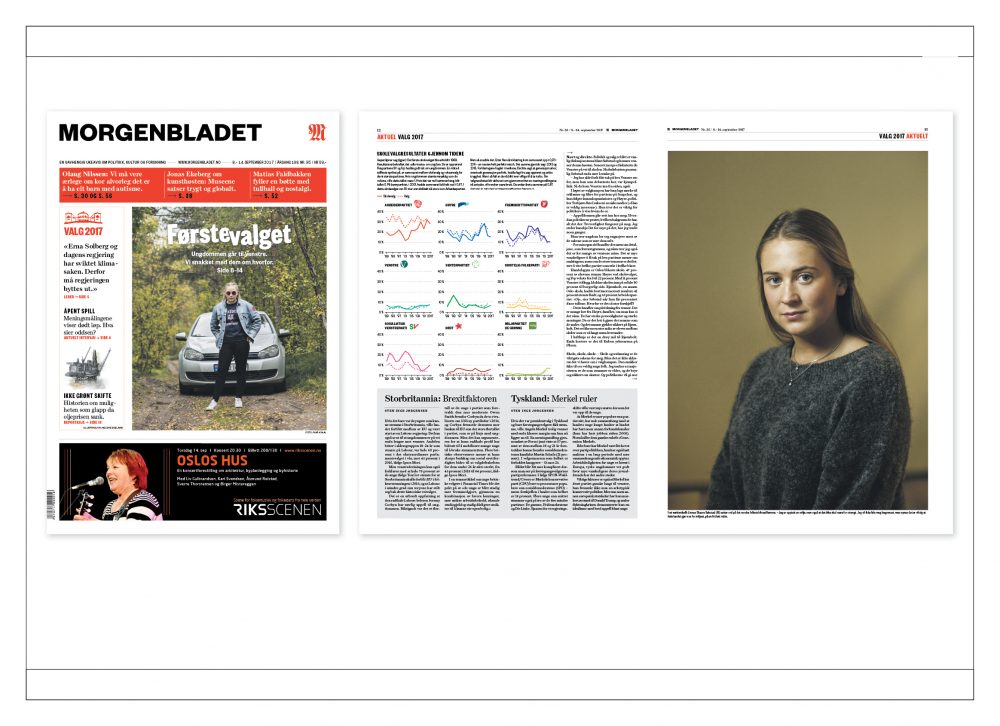
Jury-Statement
The Morgenbladet can be described in three short phrases: 1. cover and cover stories, 2. big photo-reportage and 3. topics that are visually got up with illustrations. The front page is usually devoted to a single topic. On the inside pages the treatment of images and page layout is very varied and because of the tabloid format very magazine-like. One highlight is cartoons on international-political topics. An attractive detail is the infographic of the week at the bottom of page two. All in all Morgenbladet offers an unmistakable profile content- and designwise.
The 16 members of the jury are from nine different countries: Greece, Denmark, Finland, the Netherlands, Portugal, Switzerland, Ireland, Norway, and Germany. They are journalists, scientists and designers.
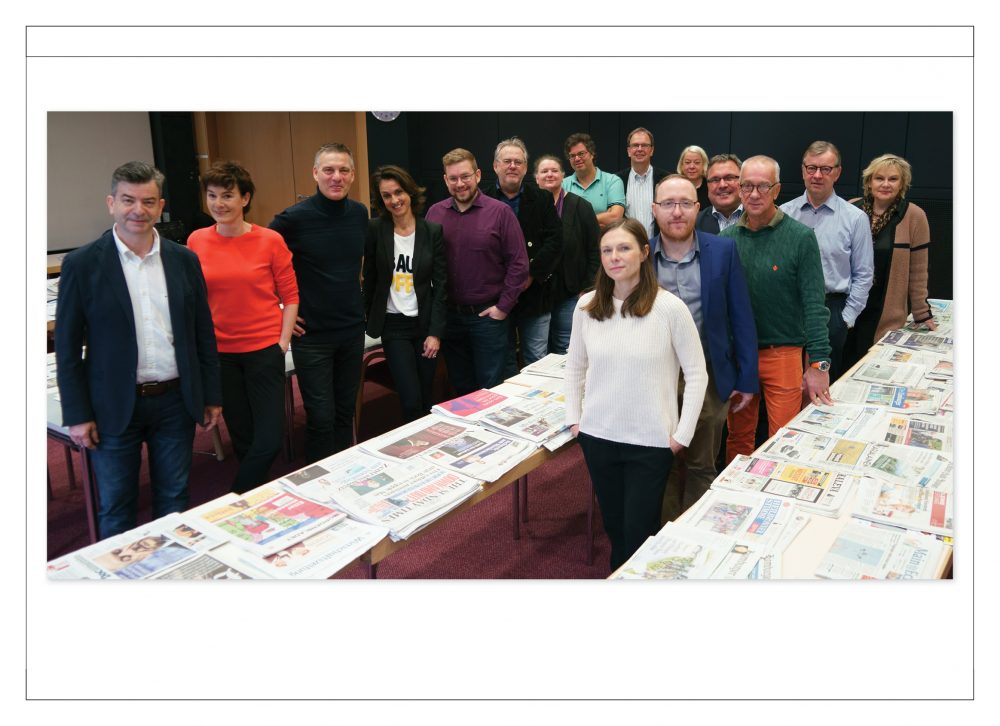
The jury of the 19th European Newspaper Award (from left):
– Dimitris Nikas, art director, H Kathimerini, GR
– Eva Dähne, art director, Stuttgarter Nachrichten, D
– Søren Nyeland, art director, Politiken, DK
– Marianne Bahl, art director, Børsen, DK
– Björn Heselius, principal designer, Nitor, FIN
– Theo Dersjant, Director Fontys School of Journalism, NL
– Alie Veenhuizen, art director, Leeuwarder Courant, NL
– Marco Grieco, art director, Expresso, P
– Detlev Scheerbarth, Märkische Allgemeine, Potsdam D
– Marianne Hartz, art director, Lebensmittel Zeitung, D
Second row:
– Tanja Starkowski, picture editor, St. Galler Tagblatt, CH
– Kevin Loftus, art director, The Mayo News, IRL
– Walter Jensen, art director, Bergens Tidende, N
– Andreas Kemper, member of the chief editorial staff, Main-Post, D
– Prof. Joachim Blum, media consultant, D
– Annette Milz, editor-in-chief, MediumMagazin, D
The members of the jury are excluded from the assessment of their own contributions.
Contact: Norbert Küpper · Office for Newspaper Design · Gutenbergstr. 4 · 40670 Meerbusch · Germany · E-Mail mail@newspaperaward.org · Phone +49 21 59 91 16 15 · Website www.newspaperaward.org
